| |
 |
 |
| |
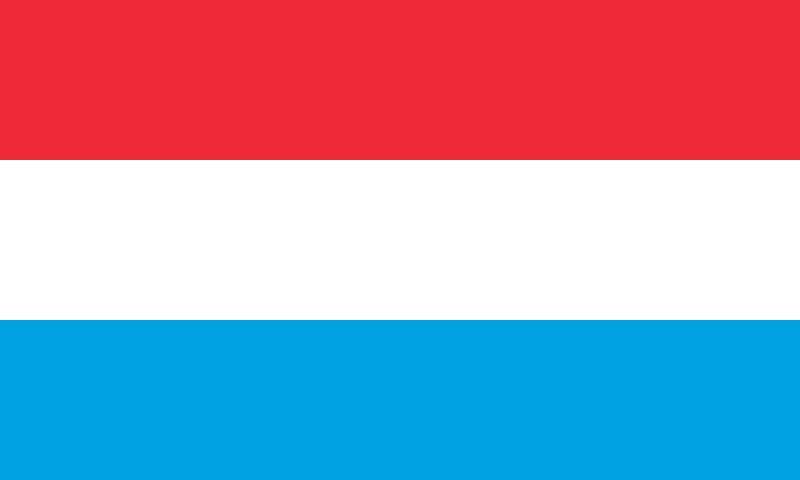 |
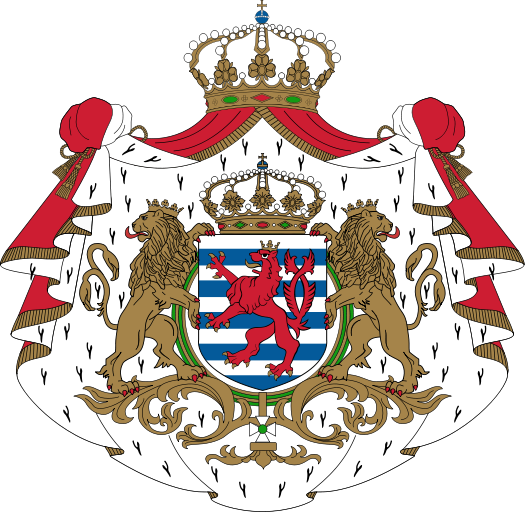 |
| |
| |
17 Apr 963 Area of modern Luxembourg acquired from the abbots of
St. Maxim at Trier; title used by the rulers
Graf im Moselgau und den Ardennen.
06 Jul 1083 Title of Count of Luxembourg adopted (Graf von
Lützelburg).
26 Jul 1199 Treaty concluded between Thibaut de Bar, Baudouin de
Flandre, and Philippe de Namur who agree to recognize
Ermesindis as ruler.
13 Mar 1354 Duchy of Luxembourg; formal separation from
Lorraine/Lothringen.
26 Feb 1388 The duchy is pledged by Wenceslas II to Jost
(Jobst/Josse/Jodok), and from this date to 23 Nov 1457
there are side by side the hereditary duke
(duc héréditaire) and the actually governing
"duke by pledge" (duc par engagère).
04 Oct 1441 Elisabeth von Görlitz sells Luxembourg to Philippe de
Bourgogne, but only to succeed upon her death.
22 Nov 1443 - 15 Jun 1467 Administered by Burgundy.
23 Nov 1457 Upon the death of hereditary duke Ladislas, "Postumus"
of Austria, the ducal line is claimed by the
Burgundian branch of the house of Valois; Anna, sister
of Ladislas, and her husband continue to claim to be
the rightful heirs. (kings of the Spanish kingdoms)
20 Mar 1459 Wilhelm II von Thüringen sells claims to Luxembourg
to France which is not recognized by Burgundy.
25 Mar 1462 France waives claim to Luxembourg by declaration.
13 Nov 1462 - 1467 Upon
the death of Anna von Österreich, her sister,
Elisabeth von Habsburg and her husband continue
to claim Luxembourg.
01 Sep 1542 - 10 Sep 1542 French occupation.
12 Sep 1543 - 06 Aug 1544 French occupation.
16 Jan 1556 - 08 May 1713 Under Spanish rule as as part of the
Spanish Netherlands
(Belgium).
04 Jun 1684 - 28 Jan 1698 French occupation.
1701 - 26 Jun 1713 French
occupation.
08 May 1713 As a consequence of the War of the Spanish Succession,
Luxembourg becomes part of the Austrian Netherlands
(Belgium)
26 Jun 1713 - 07 Jan 1715 Under Hessian administration.
07 Jan 1715 Austrians take possession.
15 Dec 1792 - 28 Apr 1793 Annexation by France.
01 Oct 1795 - 01 Feb 1814 Annexation by France (becomes département
des Forêts
18 Nov 1795).
15 Feb 1814 - 09 Mar 1814 Under Gouvernement-général de la Belgique
(Belgium).
10 Mar 1814 - 12 May 1815 Under Gouvernement-général du Rhin Moyen
(from 10 Jun 1814, Bas-Rhin et Rhin Moyen).
16 Mar 1815 Style of duke restored for Willem I of the Netherlands
(Duchy of Luxembourg).
09 Jun 1815 Grand Duchy of Luxembourg
16 Oct 1830 Belgian provisional government declares Luxembourg an
integral part of Belgium [Arlon district defects to the
revolutionaries 19 Oct 1830; district of Luxembourg
(excluding fortress of Luxembourg) on 22 Oct 1830].
22 Oct 1830 - 19 Jan 1839 Belgian occupation/administration of
Luxembourg
(except the fortress-city of Luxembourg).
17 Feb 1831 Upon separation of Belgium from the Kingdom of the
Netherlands, the already diminished territory of
Luxembourg is divided into the (larger) Belgian
province of Luxembourg and the (smaller) surviving
Grand Duchy.
19 Jun 1839 Division acquiesced to by the King/Grand-duke.
12 Jul 1845 Flag Adopted (Officially adopted 16 Aug 1972).
17 Oct 1868 Constitution
23 Nov 1890 End of the personal union with the Netherlands.
02 Aug 1914 - 11 Nov 1918 Occupied by Germany (de facto to 20 Nov
1918).
10 May 1940 - 11 Sep 1944 Occupied by Germany (administered from
Belgium 04 Jun
1940 - 02 Aug 1940; part of the Nazi party Gau
Koblenz-Trier [from Feb 1941 Moselland]
from 20 Aug 1940).
04 May 1919 Referendum favors continuation of the monarchy.
14 Aug 1940 Luxembourg constitution voided - all references
to the "Grand Duchy" or "State of Luxembourg"
in official documents prohibited by Germany.
11 Sep 1944 - 12 Apr 1945 Allied occupation.
16 Dec 1944 - 28 Jan 1945 Northern third of Luxembourg re-occupied
by Germany
during the Battle of the Bulge. |
| |
|
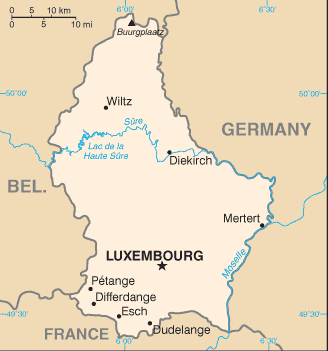 |
Luxembourg, officially the Grand Duchy of Luxembourg
(Luxembourgish: Groussherzogtum Lëtzebuerg, French: Grand-Duché de
Luxembourg, German: Großherzogtum Luxemburg), is a landlocked country in
western Europe, bordered by Belgium, France, and Germany. It has two
principal regions: the Oesling (32%) in the north as part of the Ardennes
massif, and the Gutland ["good country"] (68%) in the south. It has an area
of 2,586 square kilometres (998 sq mi).
Capital and largest city:
Luxembourg.
Motto: "Mir wëlle
bleiwe wat mir sinn" (Luxembourgish) [translation: "We want to remain what
we are"]. Luxembourg was occupied by
Germany and liberated by American troops in both World Wars, and is the
resting place of 5,000 American soldiers, including General George S.
Patton. |
| |
| |
- A compact district located in the angle
between Belgium, France, and Germany. A County, then Duchy, during the
Middle Ages, and source of one of the most powerful dynasties in western
Europe in the 14th century.
- ARDENNES
- Counts
- Odacar............................................870s
- 897
- Wigerich...........................................897
- C. 918
- Gozelo..........................................c.
918 - 19 Oct 942
- Giselbert
I.................................19 Oct 942 - 963
- LUXEMBOURG
- Sigfried S/o
possibly
Wigeric of Lotharingia.......963
- 28 Oct 998
- He is considered the first count of
Luxembourg. He was actually count in the Moselgau and the Ardennes. He
was also the advocate of the abbeys of Saint-Maximin de Trêves and
Saint-Willibrord d'Echternach. He is speculated to be the son of Count
Palatine Wigeric of Lotharingia and Cunigunda. He is the founder of the
House of Luxembourg, a cadet branch of the House of Ardennes. He had
possessions from his father in Upper Lorraine. At the centre of his
dominions he constructed the fortress of Luxembourg in 963. A town soon
grew up around the castle.
- Henry
I [Heinrich I] (at
Ardennengau).......28
Oct 998 - 27 Feb 1026
with...
- He was the son of Sigfried. Heinrich became
from 993, Heinrich V of Bavaria.
- Giselbert II S/o Sigfried
(at
Moselgau).....28
Oct 998 - 18 May 1004
-
Friedrich
S/o Sigfried (at
Moselgau).......18
May 1004 - 06 Oct 1047 with ...
- Henry
II S/o
Friedrich.....................27
Feb 1026 - 14 Oct 1047
- In 1042, he was given Bavaria by the Emperor
Henry III, who had hitherto held it, but who needed a resident duke to
deal with the raids of Samuel Aba, king of Hungary. Therefore he became
Heinrich VI of Bavaria. He never married. His brother Giselbert
succeeded him in Luxembourg, while Bavaria escheated to the emperor, who
gave it to Cuno.
- Giselbert III S/o
Friedrich................14
Oct 1047 - 14 Aug 1059
- He was count of Salm and of Longwy, then count
of Luxembourg from 1047 to 1059.
- Conrad
I [Konrad
I]
S/o Giselbert III......14
Aug 1059 - 06 Jul 1083 d. 1086
- Counts of
Luxembourg
- Conrad
I [Konrad
I] (continued)............06
Jul 1083 - 08 Aug 1086
- Henry
III [Heinrich
III]
S/o Conrad
I......08 Aug 1086 - 1096
- He was the son of Conrad and Clementia of
Aquitaine. He never married and was succeeded by his brother William.
-
William I [Wilhelm
I]
S/o Conrad
I................1096 - 23 Jan 1130
- Like his predecessors, he was embroiled in
debates with the archbishop of Trier Bruno in 1122 and 1127, leading to
William's excommunication.
- Conrad
II [Konrad
II] S/o
William I........23 Jan 1130 - 1136
- He married Ermengarde, daughter of count Otto
II of Zutphen. Conrad II died without a male heir, and so the county of
Luxembourg reverted to the Holy Roman Emperor Lothair II. The emperor in
turn did not wish the county to be rule by Conrad's closest relative
Henri de Grandpré, who was a French lord and so might align the county
with the Kingdom of France, and so granted it to Henry of Namur, a
cousin of Conrad's.
- LUXEMBOURG-NAMUR
- Henry IV the Blind
[Heinrich
IV]
S/o Godfrey I....1136
- 14 Aug 1196
- He was the son of Godfrey I, Count of Namur
and Ermesinde, a daughter of Conrad I of Luxembourg. He was Count of Namur
from 1139 until his abdication in 1189.
- HOHENSTAUFEN
-
Otto (in
dispute with Ermesinde)..................1196
- 1197 d. 1200 with...
- He was Count of Burgundy from 1190 to his
death and briefly Count of Luxembourg from 1196 to 1197. He was the
fourth son of Holy Roman Emperor Frederick I Barbarossa by his second
wife Countess Beatrice I of Burgundy, heiress of Count Renaud III. Upon
the death of his mother in 1184, his father granted him the Burgundian
county, elevating him to the rank of a Count palatine (Freigraf).
Haughty Otto however soon entered into several feuds: not only with the
Anscarid lords of Auxonne and Mâcon, who claimed late Beatrice's
heritage, but also with the Counts of Montbéliard, the French Duke Odo
III of Burgundy and Duke Berthold V of Zähringen. In the course of
negotiations in 1195, he killed Count Amadeus of Montbèliard with his
own hands, followed by the assassination of Alsatian Count Ulric of
Ferrette in 1197 and the execution of a brother of Konrad von Hüneburg,
Bishop of Strasbourg, in 1198. When Count Henry IV of Luxembourg died
without heirs in 1196, his county escheated to the Emperor and Henry VI
enfeoffed his brother Otto. Count Theobald I of Bar, who had married
Ermesinde, daughter of late Count Henry IV, negotiated the renunciation
of Luxembourg with Otto the next year. Meanwhile Count palatine Otto's
regional conflicts had become a severe threat to the power politics of
his Hohenstaufen relatives. After Philip of Swabia had been elected King
of the Romans in 1198, rivaling with the Welf duke Otto of Brunswick, he
tried to settle the numerous quarrels picked by his brother. In 1200
Otto was assassinated at Besançon, his death came in useful to many
political actors. Otto was buried at St Stephen's Cathedral, today the
site of the Citadel of Besançon.
- LUXEMBOURG-NAMUR
- Ermesinde D/o Heinrich
IV (female).........14
Aug 1196
- 12 Feb 1247
- She is Henry IV's only daughter and Otto's
fourth cousin. She also known as Ermesinde of Namur, was the Countess of
Luxembourg, Laroche and Durbuy between 1197 and 1247. She was the only
child of Henry IV, Count of Luxembourg and Namur, and his second wife,
Agnes of Guelders. Ermesinde was initially betrothed to Henry II of
Champagne, but the engagement was cancelled in 1189. Instead her first
husband was Theobald I of Bar (1158–1214). He successfully negotiated
with Otto I, Count of Burgundy for the latter's renunciation of
Luxembourg, thus making Theobald and Ermesinde the Count and Countess of
Luxembourg. When Theobald died in 1214, Ermesinde married Waleran III of
Limburg (1180–1226), who would rule as the Count of Luxembourg. In 1223
Ermesinde and Waleran pressed their claim to Namur against Margrave
Philip II, but were ultimately unsuccessful. After Walram's death,
Ermesinde ruled Luxembourg alone for two decades. She proved to be an
effective administrator, granting charters of freedom to several towns
and increasing the prosperity of her country.
-
Thibaut, comte de
Bar (regent)........14
Aug 1196 - 13 Feb 1214
- He was the husband of Ermesinde and was styled
as Count of Luxembourg. He was the son of Reginald II of Bar and his
wife Agnès de Champagne. Theobald I was married three times; to
Ermesinde (Isabella) of Bar-sur-Seine, Adelheid of Loon and to Ermesinde
(Ermesinda) of Namur. His lands in Luxembourg reverted to Waleran III of
Limburg, who married Theobald's widow Ermesinde I of Luxemburg.
-
Walram Herzog von
Limburg (regent).......May
1214 - 02 Jul 1226
- He was the husband of Ermesinde, known as
Valerien III [Waleran III], duc de Limbourg and was styled as Count of Luxembourg.
He was the son of Henry III of Limburg and Sophia of Saarbrücken.
- LUXEMBOURG-LIMBURG-ARLON
- Henry V [Heinrich
V]
S/o Waleran III.......12
Feb 1247 - 24 Dec 1281
- Henry V the Blond was also called "the Great", the count of Luxembourg, Laroche and
Arlon from 1247 to his death and the count of Namur between 1256 and
1264 as Henry III and as Hendrik IV of Limburg. He was the son and
successor of Waleran III of Limburg and Ermesinda of Luxembourg. In 1240
Henry married Margaret of Bar, daughter of Henry II of Bar and Philippa
of Dreux who was the great-granddaughter of King Louis VI of France.
Henry's marriage to Margaret brought him Ligny-en-Barrois as her dowry,
though, by a clause in the marriage contract, it remained under the
feudal suzerainty of the county of Bar. In contempt of this, Henry paid
homage in 1256 to Theobald II of Navarre, in his capacity as Count of
Champagne. Henry's brother-in-law, Theobald II of Bar, took advantage of
the conflict then raging between Frederick III of Lorraine and the
bishops of Metz. Henry V was a partisan of the duke and so Theobald took
the side of the bishop. Henry was captured in battle at Prény on 14
September 1266. On 08 September 1268, King Louis IX arbitrated between
the two counts and Henry was freed and repossessed of Ligny, but under
the suzerainty of the Barrois. In 1256, Henry seized Namur while the
reigning margrave, Baldwin II, was also reigning emperor in
Constantinople. Baldwin relinquished his rights of Namur to Guy of Dampierre, Count of Flanders, who retook the margraviate from Henry. The
two parties made peace and Guy married Henry's daughter.
- Henry
VI [Heinrich
VI]
S/o Henry V.........24
Dec 1281 - 05 Jun 1288
- Henry VI the Condemned was the son of Henry V
the Blond and Margaret of Bar. His father took part in Saint Louis's
crusade against Tunis and he continued this war, being killed alongside
three of his brothers at the Battle of Worringen by a knight of John I,
Duke of Brabant.
- Henry VII [Heinrich
VII]
S/o Henry VI......05
Jun 1288 - Jun 1310 d. 1313
- He was King of the Romans (Germany) 27
November 1308 – 24 August 1313, King of Italy 06 January 1311 – 24
August 1313 and The Holy Roman Emperor 29 June 1312 – 24
August 1313. During his brief career he reinvigorated the imperial cause
in Italy, wracked with the partisan struggles between the divided Guelf
and Ghibelline factions, and inspired the praise of Dino Compagni and
Dante Alighieri; however, his premature death undid his life's work.
Consequently, Henry skilfully negotiated his way to the crown, elected
with six votes at Frankfurt on 27 November 1308. Henry was subsequently
crowned at Aachen on 06 January 1309. In July 1309, Pope Clement V,
established at Avignon, confirmed Henry's election and initially agreed
to personally crown him Emperor at Candlemas, 1312, the title having
been vacant since the death of Frederick II. Henry in exchange, swore an
oath or protection to the Pope, agreed to defend the rights and not to
attack the privileges of the cities of the papal states, and he also
agreed to go on crusade once he had been crowned emperor. Yet the newly
crowned king had local issues to deal with before he could seek the
imperial crown.
- John I the Blind
S/o Henry VII....................1310
- 26 Aug 1346
- He was the Count of Luxembourg from 1309 and
King of Bohemia from 1310 and titular King of Poland. He was the eldest
son of the Holy Roman Emperor Henry VII and his wife Margaret of
Brabant. Like his predecessor Henry, he was disliked by much of the
Czech nobility. John was considered to be an "alien king" and gave up
the administration of Bohemia after a while and embarked on a life of
travel. He parted ways with his wife and left the Czech country to be
ruled by the barons while spending time in Luxembourg and the French
court. His travels took him to Silesia, Poland, Lithuania, Tyrol,
Northern Italy and Papal Avignon. A rival of King Władysław I the
Elbow-high to the Polish crown, John supported the Teutonic Knights in
the Polish–Teutonic War from 1326 to 1332. He also made several Silesian
dukes swear an oath of allegiance to him. In 1335 in Congress of
Visegrád, Władysław's successor King Casimir III the Great of Poland
paid a significant amount of money in exchange for John's giving up his
claim to the Polish throne. John lost his eyesight at age 39 or 40 from
ophthalmia in 1336, while crusading in Lithuania. A treatment by the
famous physician Guy de Chauliac had no positive effects. At the
outbreak of the Hundred Years' War in 1337 he allied with King Philip VI
of France and even was governor of Languedoc from 30 November 1338 to
November 1340. At the Battle of Crécy in 1346 John controlled Phillip's
advanced guard along with controling the large contingents of Charles II
of Alençon and the Louis I, Count of Flanders. John was killed at age 50
while fighting against the English during the battle of Crécy, after
having been blind for a decade. Before he died in battle, he was
reported to have said: "Let it never be the case that a Bohemian king
runs [from a fight]!"
- Charles I S/o John I the Blind.............26
Aug 1346
- 19 Dec 1353 d. 1378
- Charles I the Popish King was King of the
Romans (Germany) 11 July 1346 – 29 November 1378, King of Bohemia 26
August 1346 – 29 November 1378, Holy Roman Emperor (Charles IV), King of Italy 06
January/05 April 1355 – 29 November 1378 and King of Burgundy 04 June
1365 – 29 November 1378. On 11 July 1346, prince-electors elected him
King of the Romans (rex Romanorum) in opposition to Emperor Louis IV.
Charles was crowned on 26 November 1346 in Bonn. After his opponent
died, he was re-elected in 1349 (17 June) and crowned (25 July) King of
the Romans. In 1355 he was crowned King of Italy on 6 January and Holy
Roman Emperor on 5 April. With his coronation as King of Burgundy,
delayed until 4 June 1365, he became the personal ruler of all the
kingdoms of the Holy Roman Empire. On 11 July 1346, in consequence of an
alliance between his father and Pope Clement VI, relentless enemy of the
emperor Louis IV, Charles was chosen as Roman king in opposition to
Louis by some of the prince-electors at Rhens. In 1354 he crossed the
Alps without an army, received the Lombard crown in St. Ambrose
Basilica, Milan, on 05 January 1355, and was crowned emperor at Rome by a
cardinal in the April of the same year. He left the position of Count of
Luxembourg to his brother on 15 Nov or 19 Dec 1353.
- Wenceslaus
I S/o John I the Blind..........19 Dec 1353 -
13 Mar 1354
- Wenceslaus I (also Wenczlaw, Wenceslas,
Venceslas, Wenzel, or Václav, often called Wenceslaus of Bohemia in
chronicles) (born in Prague, 25 February 1337 – died in Luxembourg, 07
December 1383) was the first Duke of Luxembourg from 1355. He was the
son of John the Blind, King of Bohemia, and Beatrice of Bourbon (2nd
wife). In 1353 Charles IV King of Bohemia, Count of Luxembourg and
elected Holy Roman King, entrusted the county, their father's
inheritance, to his half-brother Wenceslaus. In 1355 when Charles was
crowned Holy Roman Emperor he raised Luxembourg to the status of a
duchy. In 1352, Wenceslaus married Joanna (1322 – 1406), daughter of
John III, Duke of Brabant and Limburg, and Marie d'Évreux. In 1355,
Joanna inherited Brabant and Limburg. In order to guarantee the
indivisibility of Brabant, Wenceslaus signed the Joyous Entry, but had
to fight against his brother-in-law Louis II of Flanders, who asserted
his share of the duchy. He failed to prevent the seizure of Brussels by
the Flemings, but a certain Everard 't Serclaes succeeded by an
audacious coup in driving them out of the city. Thereafter, Wenceslaus
had to face primarily internal disorders. In 1371, he overestimated his
military capacities and waged war with William II, Duke of Jülich,
resulting in the humiliating defeat of Baesweiler, losing a part of his
army, and several noblemen. He was captured and suffered 11 months of
captivity. He died in Luxembourg and was succeeded by Antoine de Valois
as duke of Brabant and by Wenceslaus II as duke of Luxembourg. There are
speculations that he might have died of leprosy (Joanna stayed in
Brussels). His last wish was his heart to be displaced from his dead
body and sent to his wife. He is buried in a crypt at the ruins of
Abbaye d'Orval in Belgium. Wenceslaus I of Luxembourg wrote troubadour
poetry which was found by Auguste Longnon in Jean Froissart's Méliador
in 1890s (Wenceslas was a maecenas of this chronicler). It comprises 79
poems (11 ballades, 16 virelais, 52 rondeaux).
- Dukes
- Wenceslaus
I S/o John I the Blind..........19 Dec 1353 - 08 Dec 1383
- Wenceslaus II S/o
Charles I................08 Dec 1383 - 26 Feb 1388
- He was the son of Charles I and Anna von
Schweidnitz (third wife). Wenceslaus (also Wenceslas; Czech: Václav;
German: Wenzel, nicknamed der Faule ("the Idle"); 26 February 1361 – 16
August 1419) was, by inheritance, King of Bohemia (as Wenceslaus IV)
from 1363 and by election, German King (formally King of the Romans), 10
June 1376 – 20 August 1400. Wenceslaus was deposed in 1400 as German
King, but continued to rule as King of Bohemia, 29 November 1378 – 16
August 1419. He was Elector and Margrave of Brandenburg 02 October 1373
– 29 November 1378. Wenceslaus was born in the Imperial city of
Nuremberg, the son of Holy Roman Emperor Charles IV by his third wife
Anna von Schweidnitz, a scion of the Silesian Piasts, and baptized at
St. Sebaldus Church. He was raised by the Prague Archbishops Arnošt of
Pardubice and Jan Očko z Vlašimi. His father had the two-year-old
crowned King of Bohemia in 1363 and in 1373 also obtained for him the
Electoral Margraviate of Brandenburg. When in 1376 Charles IV asserted
Wenceslaus' election as King of the Romans by the prince-electors, two
of seven votes, those of Brandenburg and Bohemia, were held by the
emperor and his son themselves.
- Dukes -
Duchy of Luxembourg
- Jobst S/o John
Henry (1st time)............26
Feb 1388 -
15
Sep 1402
- Jobst (or Jost or Jodokus) of Moravia, Jobst
von Mähren (Czech: Jošt Lucemburský or Jošt Moravský; French: Josse de
Luxembourg; 1351 – 18 January 1411) from the House of Luxembourg was the
eldest son of Margrave John Henry of Moravia, the younger brother of
Emperor Charles IV. Jobst was Margrave of Moravia (12 November 1375–18
January 1411), Elector of Brandenburg (1388–18 January 1411), Duke of
Luxembourg (1388–18 January 1411) and King of Germany [formally King of
the Romans] 01 October 1410–18 January 1411. Jobst married twice, but
had no children.
-
Louis, duc d'Orléans
(Governor)............15
Sep 1402 - 23 Nov 1407
- Jobst S/o John
Henry (2nd time)............23
Nov 1407 -
18
Jan 1411
- Elizabeth of
Görlitz D/o John (female).....18
Jan 1411 - 22 Nov 1443 d. 1451
- Elisabeth was the only daughter and heiress of
John of Görlitz, the third son of Charles IV, Holy Roman Emperor. He was
Duke of Lusatia and Görlitz, and also Elector of Brandenburg for a brief
period. Her mother, Richardis Catherine of Sweden, was the daughter of
King Albert of Sweden. The Duchy of Luxembourg was mortgaged to
Elisabeth by her uncle the King Sigismund of Hungary, who later also
became King of Bohemia and Holy Roman Emperor. He was unable to repay
the loan, and subsequently left Elisabeth in control of the duchy. Her
first marriage took place in Brussels on 16 July 1409, to Antoine, Duke
of Brabant. He defended her against three uprisings of the Luxembourg
nobility, until his death in 1415. They had two children. John of
Bavaria was her second husband. He died in 1425, and they did not have
any children. After his death, she became heavily indebted. On 04 Oct
1441, she made a treaty with Philip III, Duke of Burgundy, allowing him
to immediately assume the administrative duties of Luxembourg and
inherit the duchy upon her death. He agreed to this, but chose to launch
a night attack on the territory two years later, taking immediate
control. Elisabeth was subsequently expelled from Luxembourg by Philip's
forces. She died on 02 August 1451 (aged 60) at Trier.
- CAPET-Burgundy
(Husbands of Elisabeth, styled Duke of Luxembourg)
- Antoine, Duke of
Brabant and Limburg..18 Jan 1411 - 25 Apr 1415
- Anthony, Duke of Brabant, also known as
Antoine de Brabant, Antoine de Bourgogne and Anthony of Burgundy (August
1384 – 25 October 1415, in the battle of Agincourt), was Duke of
Brabant, Lothier and Limburg. Anthony was the son of Philip II, Duke of
Burgundy and Margaret III of Flanders, and brother of John the Fearless.
He married at Arras on 21 February 1402 Jeanne de St. Pol (d. 1406),
daughter of Waleran III of Luxembourg, Count of Ligny and Saint-Pol.
They had two children: John IV, Duke of Brabant (1403–1427) and Philip
of St. Pol (1404–1430) - Duke of Brabant. Anthony married again at
Brussels on 16 July 1409, Elisabeth of Görlitz, duchess of Luxembourg
(November 1390 – 08 August 1451), daughter of John - Duke of Görlitz.
They had two children from this marriage.
- John III, Duke of Bavaria-Straubing...09 Jun 1419 - 06 Jan 1425
- He was John III the Pitiless, Duke of Bavaria-Straubing
(1374–1425), of the House of Wittelsbach, was first bishop of Liège
1389–1418 and then duke of Bavaria-Straubing and count of Holland and
Hainaut 1418–1425. John was the youngest son of Duke Albert I and
Margaret of Brieg. In 1418, John III married Elisabeth, Duchess of
Luxembourg, who was then the widow of Antoine, Duke of Brabant. No
children came from this marriage.
- Governors
-
Jakob von Sierck......................01
May 1441 - 04 Oct 1441
- Archbishop of Trier Jakob I, was not allowed
to take office.
|
| |
- Claimants
- As Elisabeth had no surviving children, she
sold Luxembourg to Philip III, Duke of Burgundy in 1441 but only to
succeed upon her death. Philip captured the city of Luxembourg in 1443,
but did not assume the ducal title because of conflicting claims by Anne
of Austria, the closest Luxembourg relative.
- Wenczlaw II S/o
Charles I..................26 Feb 1388 - 16 Aug 1419
- Sigismund S/o
Charles I....................16 Aug 1419 - 09 Dec 1437
- He was the son of Charles I and Elizabeth of
Pomerania (4th wife). Sigismund was known as Zsigmond of Hungary. King
of the Romans (Germany) 1410-1437, King of Bohemia 1419-1437, Holy Roman
Emperor 1433-1437 and King of Hungary & Croatia (with Mary) 1387–1437.
- Elisabeth I D/o
Sigismund (female).........09
Dec 1437 - 19 Dec 1442 with...
- Elisabeth of Luxembourg (born: Visegrád,
Hungary on 07 October 1409 – died: Győr, Hungary on 19 December 1442)
was a queen consort of Hungary, Bohemia and Duchess consort of Austria.
She was the interim regent of Hungary in 1439–1440, and a throne
claimant and one of the participants in the Hungarian civil war
1440–1442. She was the only child of Sigismund, Holy Roman Emperor, king
of Hungary and Bohemia, by his second wife, Barbara of Celje. Her father
was the last male descent of the House of Luxembourg on the Imperial
Throne. On 28 September 1421, Pozsony, Hungary (now Bratislava,
Slovakia, Pressburg in German) Elisabeth married Albert V, Duke of
Austria, thus becoming Duchess of Austria. After her father died in
1437, Albert was elected King of Hungary, and then King of Bohemia and
King of Germany. She was thus Queen consort of Hungary, Bohemia and
Germany. Elisabeth was crowned on 01 January 1438 by the Bishop of
Veszprém.
- Albrecht S/o
Albrecht IV Duke of Austria...09 Dec 1437 - 27 Oct 1439
- He is known as Albrecht V of Austria, Albert
II of Germany. He was married to Elisabeth of Luxembourg. Albert was
born in Vienna as the son of Albert IV, Duke of Austria, and Johanna
Sophia of Bavaria. King of Hungary & Croatia 18 December 1437 – 27
October 1439, King-elect of Germany 18 March 1438 – 27 October 1439,
King of Bohemia 06 May 1438 – 27 October 1439 and Duke of Austria 14
September 1404 – 27 October 1439.
- Ladislaus "Postumus"
S/o Albrecht..........22 Feb 1440 - 23 Nov 1457
- The only son of Albert II, King of the Romans,
and Elizabeth of Luxembourg, daughter of the Holy Roman Emperor
Sigismund. He was called Ladislaus Postumus (Czech: Ladislav Pohrobek,
Hungarian: Utószülött László, Slovenian and Croatian: Ladislav Posmrtni)
because he was born at Komárom (then part of Hungary, now Komárno in
Slovakia), four months after his father's death. He succeeded
immediately as Duke of Austria and head of the House of Habsburg, and he
also became nominal King of Bohemia (18 Oct 1453 - 23 Nov 1457). King of
Hungry and Croatia 22 February 1440 – 23 November 1457. His second
cousin Frederick V, ruler of Inner Austria, was chosen to succeed Albert
II as King of the Romans (Germany). Ladislaus's another cousin Albert VI
succeeded him in Austria; Hungary elected Matthias Corvinus, the brother
of Ladislaus Hunyadi, as king; and Bohemia elected George of Poděbrady,
the only Hussite ruler of that kingdom.
- Anna von
Österreich D/o Albrecht (female)..23
Nov 1457 - 20 Mar 1459
- Anne of Bohemia and Austria (12 April 1432 –
13 November 1462) was a Duchess of Luxembourg in her own right, and as
consort, Landgravine of Thuringia and of Saxony. She was the eldest
daughter of Albert of Austria, the future Emperor-Elect and Elisabeth,
queen of Bohemia, the sole descendant of Sigismund, Holy Roman Emperor.
Her posthumous brother Ladislaus, Duke of Austria (1440–57) succeeded,
very underage, as king of Bohemia and later also as king of Hungary.
Anne also had a younger sister, Elisabeth, who was to become later a
queen of Poland and grand duchess of Lithuania. On 02 June 1446 the
young Anne was married to William "the Brave" of Saxony (1425–82),
Landgrave of Thuringia, a younger son of Frederick I "the Warlike" of
Saxony. In right of Anne, William became Duke of Luxembourg from 1457
when Anne's brother Ladislaus died childless. Though, their rights to
the land were disputed by Philip III, Duke of Burgundy, and in 1469,
William concluded that the possession's keeping was untenable against
Burgundian attacks, and retreated to his Thuringian lands – that however
took place when Anne was already dead.
- Wilhelm II von
Thüringen (regent)....23
Nov 1457 - 20 Mar 1459
- William of Luxembourg (30 April 1425 – 17
September 1482), called the Brave (in German Wilhelm der Tapfere),
was Landgrave of Thuringia (from 1445) and Duke of Luxemburg (from
1457). He is actually the second William to rule Thuringia and the
first in Luxembourg; he was the third Margrave of Meissen named
William. He was a younger son of Frederick I the Warlike, elector of
Saxony, and Catherine of Brunswick and Lunenburg. On 2 June 1446 he
married Anne of Luxembourg, daughter of Albert II, King of Germany,
Bohemia and Hungary and Elisabeth of Luxembourg. On behalf of his
wife, he became Duke of Luxembourg from 1457 to 1469. They had two
daughters, Margaret of Thuringia (1449–1501) and Catherine of
Thuringia (1453 – 10 July 1534), who married Duke Henry II of
Münsterberg. William minted a silver groschen known as the Judenkopf
Groschen. Its obverse portrait shows a man with a pointed beard
wearing a Jewish hat, which the populace took as depicting a typical
Jew.
- Philippe "le Bon"
(Governor)......................20
Mar 1459 - 25 Nov 1462
- Elisabeth II von
Habsburg D/o Albrecht (female)...13
Nov 1462 - 1467 with...
- Elisabeth was the daughter of Albert II of
Habsburg (1397–1439), known also as Albert of Hungary and King of
Bohemia; and his wife Elisabeth of Luxembourg, daughter of King of
Bohemia and Holy Roman Emperor Sigismund of Hungary. Upon the death of
her father in 1439 she was brought up at the court of Frederick III in
Vienna. There she became acquainted with many artists and poets. On 10
March 1454, she married King Casimir IV of Poland. Four of her sons
became kings, which is why she is also called "mother of the Jagiellons"
(or "mother of kings"). Elisabeth after marriage became Queen consort of
Poland and Grand Duchess consort of Lithuania (1454–1492). She died on
30 August 1505.
- Casimir Jagiello..................................13
Nov 1462 - 1467
- He is known as Kazimierz IV Jagiellonczyk of
Poland and was husband of Elisabeth II, styled Duke of Luxembourg.
Casimir (born: 30 November 1427 – died: 07 June 1492) was the second son
of King Władysław II Jagiełło (Jogaila), and the younger brother of
Władysław III of Varna. He became Grand Duke of Lithuania (29 June 1440
– 07 June 1492) and King of Poland (25 June 1447 – 07 June 1492).
|
| |
| |
- VALOIS-BURGUNDY - Duchy of
Burgundy
- Duke
-
Philippe (I)
"le Bon" S/o John the Fearless.22 Nov 1443 - 15 Jun 1467
- He was Philippe III of Burgundy and severed as
the Governor, nominally for Elisabeth von Görlitz until her death on 03
Aug 1451, then continuing after death of Ladislaus the Posthumous. He
was Born in Dijon in 1396. His parents were John the Fearless and
Margaret of Bavaria-Straubing.
-
Charles
II the bold S/o Philippe...........15 Jun 1467 - 05 Jan 1477
- He was Charles I of Burgundy. Charles the Bold
was born in Dijon, the son of Philip the Good and Isabella of Portugal.
-
Maria D/o Charles
II the bold (female).....05
Jan 1477 - 27 Mar 1482 with...
- She was Marie "la Riche" of Burgundy.
As the only child of Charles the Bold, Duke of Burgundy, and his wife
Isabella of Bourbon, she was the heiress to the vast, and vastly
wealthy, Burgundian domains in France and the Low Countries upon her
father's death in the Battle of Nancy on 05 January 1477 and was
accordingly often referred to as "Mary the Rich". She selected Holy
Roman Emperor Archduke Maximilian of Austria for marriage, who became
her co-ruler. The marriage took place at Ghent on 18 August 1477. The
event initiated two centuries of contention between France and the
Habsburgs (later of Spain, then of Austria) for their possession, which
climaxed in the War of the Spanish Succession, 1701–1714. In the
Netherlands, affairs now went more smoothly, the French aggression was
temporarily checked, and internal peace was in large measure restored.
-
Maximilian S/o
Frederick III...............05 Jan 1477 - 27 Mar 1482 d. 1519
- He was the son of Frederick III, Holy Roman
Emperor and Eleanor of Portugal. Maximilian I was King of the Romans
(also known as King of the Germans) from 16 February 1486 and Holy Roman
Emperor from 19 August 1493 until his death on 12 January 1519, though
he was never in fact crowned by the Pope, the journey to Rome always
being too risky. He had ruled jointly with his father for the last ten
years of his father's reign, from c. 1483. He expanded the influence of
the House of Habsburg through war and his marriage in 1477 to Mary of
Burgundy, the heiress to the Duchy of Burgundy, but he also lost the
Austrian territories in today's Switzerland to the Swiss Confederacy.
-
Philippe
II S/o Maximilian.................27 Mar 1482 - 27 Jun 1506
- He is known as Philippe IV of Burgundy and
Felipe I of Spain. Philip (22 July 1478 – 25 September 1506). He was
also known as
Philip the Handsome or the Fair and was the first member of the house of
Habsburg to be King of Castile and Léon (27 June – 25 September 1506).
He was the son of Maximilian I, Holy Roman Emperor, Philip inherited the
greater part of the Duchy of Burgundy and the Burgundian Netherlands (as
Philip IV) from his mother, Mary of Burgundy, and briefly succeeded to
the Crown of Castile as the husband of Queen Joanna of Castile, who was
also heiress-presumptive to the Crown of Aragon. After Mary's early
death in 1482, Maximilian attempted to secure the Burgundian heritance
to one of his and Mary's children, Philip the Handsome. Charles VIII of
France contested this, using both military and dynastic means, but the
Burgundian succession was finally ruled in favour of Philip in the
Treaty of Senlis in 1493. Philip was the first Habsburg monarch in
Spain. He never inherited his father's territories, nor became Holy
Roman Emperor, because he predeceased his father, but his son Emperor
Charles V eventually united the Habsburg, Burgundian, Castilian, and
Aragonese inheritances. Philip on 20 October 1496, married Infanta
Joanna, daughter of King Ferdinand II of Aragon and Queen Isabella I of
Castile, in Lier, Belgium. His wife is also known as Joan the Mad,
heiress of Castile, Aragon and most of Spain. Phillip and Joan had six
children, the eldest of whom became Charles V and inherited the kingdoms
of Castile and Aragon, including their colonies in America; Southern
Italy, Austria and the Low Countries.
- HABSBURG of Spain
-
Philippe
II S/o Maximilian (continued).....27
Jun 1506 - 25 Sep 1506
-
Charles III S/o
Philippe II (1st time).....25
Sep 1506 - 01 Sep 1542 d. 1558
- Charles III, the Golden One was eldest son of
Philip the Handsome and Joanna the Mad. He became the Lord of the
Netherlands and Count Palatine of Burgundy (25 September 1506 – 25
October 1555), King of Spain as Carlos I with Joanna the Mad (23 January
1516 – 16 January 1556), Holy Roman Emperor, King of the Romans and King
of Italy as Karl V (28 June 1519 – 27 August 1556). He voluntary
retirement and abdication in favor of his younger brother Ferdinand I
for Holy Roman Emperor and his son Philip II for Spain in 1556.
- France.....................................01
Sep 1542 - 10 Sep 1542
- French
Governors
- Claude de
Lorraine, duc de Guise......01 Sep 1542 - 10 Sep 1542 d. 1550
-
Charles III S/o
Philippe II (2nd time).....10
Sep 1542 - 12 Sep 1543 d. 1558
- France.....................................12
Sep 1543 - 06 Aug 1554
- French
Governors
- François
d'Anglure....................12 Sep 1543 - 1544 d. 1544
- François de
Clèves, duc de Nevers............1544 - 06 Aug 1545 d. 1562
-
Charles III S/o
Philippe II (3rd time).....06
Aug 1544 - 25 Oct 1555 d. 1558
-
Maria von Habsburg (female -
Regent)..26 Jun 1548 - 25 Oct 1555 d. 1558
-
Philippe
III S/o
Charles III...............25 Oct 1555 - 13 Sep 1598
- Philip was born in Valladolid, the son of
Charles V, Holy Roman Emperor and King of Spain, and his consort,
Isabella of Portugal. Philip III the Prudent was the King of Naples (25
July 1554 – 13 September 1598), King of England and Ireland (jure uxoris)
[25 July 1554 – 17 November 1558], King of Spain as Felipe II (16
January 1556 – 13 September 1598) and King of Portugal and the Algarves
(25 March 1581 – 13 September 1598).
-
Isabella Clara
Eugenia D/o Philippe
III....13 Sep 1598 - 13 Jul 1621 with...
- She was the daughter of Philip II of Spain and
his third wife Elisabeth of Valois. She became Duchess of Brabant,
Limburg, Lothier, Luxemburg and Guelders; Margravine of Namur; Countess
Palatine of Burgundy; Countess of Artois, Flanders, Charolais and
Hainaut (06 May 1598 – 13 July 1621). Her father decided to cede the
Spanish Netherlands to her on condition that she marry her cousin,
Archduke Albert of Austria. They were to reign over the Netherlands
jointly as duke/count and duchess/countess. They were to be succeeded by
their descendants according to the male-preference cognatic
primogeniture but should a female succeed, she was required to marry the
King of Spain or the person chosen by the King of Spain. It was also
stipulated that, should they have no children, the Netherlands would
revert to the King of Spain upon the death of either spouse. On 18 April
1599, being 33 years old, she married Albert, the younger brother of her
former fiancé Rudolf II. Albert was the joint sovereign of the Spanish
Netherlands and the former viceroy of Portugal. As Albert also was the
Archbishop of Toledo, he had to be released from his religious
commitments by Pope Clement VIII before the wedding could take place.
Shortly before Philip II died on 13 September 1598, he renounced his
rights to the Netherlands in favor of his daughter Isabella and her
fiancé. Isabella later bore Albert three children, Archdukes Philip
(born 21 October 1605) and Albert (born 27 January 1607) and Archduchess
Anna Mauritia; however, all three died in infancy.
-
Albert VII of
Austria S/o Maximilian II....13 Sep 1598 - 13 Jul 1621
- Archduke Albert was the fifth son of Emperor
Maximilian II, and the Infanta Maria, daughter of Emperor Charles V, and
Isabella of Portugal.
-
Philippe V S/o
Philippe IV.................31 Jul 1621 - 17 Sep 1665
- Philip V the Great was born in Valladolid, and
was the eldest son of Philip IV (Philip III of Spain) and his wife,
Margaret of Austria. Philip V was King of Spain as Philip IV (31 March
1621 – 17 September 1665), King of Portugal and the Algarves (31 March
1621 – 01 December 1640), Prince of Piombino (1628-1634) and Count of
Artois (13 July 1621 - 07 November 1659).
-
Charles IV S/o
Philippe V (1st
time).......17 Sep 1665 - 04 Jun 1684
- Charles IV the Bewitched was born in Madrid in
1661, the only surviving son of his predecessor, King Philip IV of Spain
and his second Queen (and niece), Mariana of Austria. His birth was
greeted with joy by the Spanish, who feared the disputed succession
which could have ensued if Philip IV had left no male heir. Charles was
King of Spain as Carlos II (17 September 1665 – 01 November 1700) and
Count Palatine of Burgundy (17 September 1665 - 19 September 1678).
- BOURBON of France
-
Louis-Dieudonné "le
Grand".................04 Jun 1684 - 20 Sep 1697 d. 1715
- Louis XIV was born on 5 September 1638 in the
Château de Saint-Germain-en-Laye to Louis XIII and Anne of Austria. At
that time, his parents had already been married for 23 years. His mother
had experienced four stillbirths between 1619 and 1631. Leading
contemporaries thus regarded him as a divine gift, and his birth, a
miracle of God. He was often referred to as "Louis-Dieudonné"
(Louis-God-given). His reign of 72 years and 110 days is one of the
longest in French and European history, ruled as King of France and
Navarre (14 May 1643 – 01 September 1715). During Louis's reign France
was the leading European power and fought three major wars: the
Franco-Dutch War, the War of the League of Augsburg and the War of the
Spanish Succession, as well as two lesser conflicts, the War of
Devolution and the War of the Reunions. Louis encouraged and benefited
from the work of prominent political, military and cultural figures such
as Mazarin, Colbert, the Grand Condé, Turenne and Vauban, as well as
Molière, Racine, Boileau, La Fontaine, Lully, Le Brun, Rigaud, Bossuet,
Le Vau, Mansart, Charles and Claude Perrault, and Le Nôtre.
- French
Governor and Lieutenant-General
- Henri de
Lambert.......................12 Jun 1684 - Jul 1686 d. 1686
- He was known as Henri de Lambert, marquis de
Lambert et de Saint Bris, baron de Citry.
- French
Governor
- Louis-François,
duc de Boufflers......10 Aug 1686 - Jul 1687 d. 1711
- Nicolas de Catinat....................25
Jul 1687 - 1690 d. 1712
- He was known as Nicolas de Catinat, seigneur
de Saint Gratien. From Mar 1690, he became Lieutenant-general.
- Within the
Prov. of Lorraine 1690-1697
- Henri, duc de
Harcourt.......................1690 - 1697? d. 1718
- Louis-François du
Parc, marquis.....................1697 d. 1709
- HABSBURG of Spain
-
Charles IV (2nd
time)......................20 Sep 1697 - 01 Nov 1700
- Spanish Governor and
captain-general
- Jean-Frédéric, comte d'Autel..........15
Nov 1697 - 1713 d. 1716
- Interregnum................................01 Nov 1700 - 16 Nov 1700
- Under the authority of the
Governing Board in Spain. During the War of Spanish Succession,
1701–1714, the duchy was disputed between Philip of Anjou, grandson of
Louis XIV of France, from the House of Bourbon and Charles of Austria,
son of Leopold I, Holy Roman Emperor, from the House of Habsburg. In
1712 Luxembourg and Namur were ceded to Maximilian II Emanuel, Elector
of Bavaria by his French allies, but with the end of the war in 1713
with the Treaty of Utrecht Max. Emanuel was restored Elector of Bavaria.
In 1713 the duchy fell to the Austrian branch of the House of Habsburg.
- BOURBON of France
-
Philippe
VI................................16 Nov 1700 - 25 May 1711 d. 1746
- He was know as Felipe V of Spain (01 November
1700 – 15 January 1724). On 15 January 1724, he abdicated in favor of
his son Louis, and from 06 September 1724, when he assumed the throne
again upon his son's death, to his death on 09 July 1746. Prior to his
centralisation of Spain in 1707, he was known in Aragon as Philip IV.
- WITTELSBACH of Bavaria (Germany)
-
Maximilien Marie
Emmanuel..................25 May 1711 - 08 May 1713 d. 1726
- Full Name: Maximilian Emanuel Ludwig Maria
Joseph Kajetan Anton Nikolaus Franz Ignaz Felix.
He is known as Maximilian II, Wittelsbach ruler of Bavaria (1679-1726)
and a Kurfürst of the Holy Roman Empire. He was also the last governor
of the Spanish Netherlands and duke of Luxembourg. An able soldier, his
ambition led to conflicts that limited his ultimate dynastic
achievements. He was born in Munich to Ferdinand Maria, Elector of
Bavaria and Henriette Adelaide of Savoy (d. 1676). His maternal
grandparents were Victor Amadeus I of Savoy and Christine Marie of
France, daughter of King Henri le Grand.
- HABSBURG (Archdukes of Austria)
- Interregnum................................08 May 1713 - 07 Jan 1715
- Hessian Governors /
Administrators
- Reinhardt Vincent, baron Hompesch............1713
- 1714 d. 1733
- Johan Rabo, baron van
Keppel..........01 Jun 1714 - 1715? d. 1733
-
Charles
IV S/o Leopold I...................07 Jan 1715 - 20 Oct 1740
- Full name: Karl Franz Joseph Wenceslau
Balthasar Johann Anton Ignatius. He was the
second son of the Emperor Leopold I and of his third wife, Princess
Eleonor Magdalene of Neuburg, was born on 1 October 1685. His tutor was
Anton Florian, Prince of Liechtenstein. He succeeded his elder brother,
Joseph I, as Holy Roman Emperor, King of Bohemia (Charles II) [12
October 1711 – 20 October 1740], Hungary and Croatia (Charles III),
Archduke of Austria [17 April 1711 – 20 October 1740]. He unsuccessfully
claimed the throne of Spain as Charles III following the death of its
ruler, and Charles's relative, Charles II of Spain, in 1700. He married
Elisabeth Christine of Brunswick-Wolfenbüttel, by whom he had his two
children: Maria Theresa, born 1717, the last Habsburg sovereign, and
Maria Anna, born 1718, Governess of the Austrian Netherlands.
-
Maria
II Theresa D/o Charles
IV............20 Oct 1740 - 29 Nov 1780 with...
- Maria Theresa Walburga Amalia Christina
(German: Maria Theresia; 13 May 1717 – 29 November 1780) was the only
female ruler of the Habsburg dominions and the last of the House of
Habsburg. She was the sovereign of Austria, Hungary, Croatia, Bohemia,
Mantua, Milan, Lodomeria and Galicia, the Austrian Netherlands and
Parma. By marriage, she was Duchess of Lorraine, Grand Duchess of
Tuscany and Holy Roman Empress. She started her 40-year reign when her
father, Emperor Charles VI, died in October 1740. Charles VI paved the
way for her accession with the Pragmatic Sanction of 1713 and spent his
entire reign securing it. Upon the death of her father, Saxony, Prussia,
Bavaria and France repudiated the sanction they had recognised during
his lifetime. Prussia proceeded to invade the affluent Habsburg province
of Silesia, sparking a nine-year conflict known as the War of the
Austrian Succession. Maria Theresa would later unsuccessfully try to
reconquer Silesia during the Seven Years War. Maria Theresa and her
husband, Francis I, Holy Roman Emperor, had sixteen children, including
Queen Marie Antoinette of France, Queen Maria Carolina of Naples,
Duchess Maria Amalia of Parma and two Holy Roman Emperors, Joseph II and
Leopold II.
- HABSBURG-LORRAINE
-
Francis I Stephen S/o
Leopold Joseph.......20 Oct 1740 - 18 Aug 1765
- François Étienne was born in Nancy, Lorraine
(now in France), the oldest surviving son of Leopold Joseph, duke of
Lorraine, and his wife Élisabeth Charlotte d'Orléans, daughter of
Philippe, duc d'Orléans. He was connected with the Habsburgs through his
grandmother Eleonor, daughter of Emperor Ferdinand III, and wife of
Charles Leopold of Lorraine, his grandfather. He was very close to his
brother and sister Anne Charlotte. He was Holy Roman Emperor (13
September 1745 – 18 August 1765) and Grand Duke of Tuscany, though his
wife effectively executed the real powers of those positions. With his
wife, Maria Theresa, he was the founder of the Habsburg-Lorraine
dynasty. From 1728 until 1737 he was Duke of Lorraine, but lost this
title when Lorraine was seized by France in the War of the Polish
Succession; he was compensated with Tuscany in the peace treaty that
ended that war. He was the father of the deposed and later executed
French Queen Marie Antoinette.
-
Joseph S/o
Francis I.......................29 Nov 1780 - 20 Feb 1790
- Joseph II (Joseph Benedikt August Johannes
Anton Anton Michael Adam; 13 March 1741 – 20 February 1790) was King of
the Romans (King in Germany) [27 March 1764 – 20 February 1790] and Holy
Roman Emperor (18 August 1765 – 20 February 1790) and ruler of the
Habsburg lands (King of Hungary and Croatia, King of Bohemia and
Archduke of Austria) from 1780 to 1790. He was the eldest son of Empress
Maria Theresa and her husband, Francis I. He has been ranked, with
Catherine II of Russia and Frederick II of Prussia, as one of the three
great Enlightenment monarchs. His policies are now known as Josephinism.
He died with no sons and was succeeded by his younger brother, Leopold.
-
Leopold S/o
Francis I......................20 Sep 1790 - 01 Mar 1792
- Leopold II (05 May 1747 – 01 March 1792), born
Peter Leopold Joseph Anton Joachim Pius Gotthard, was Holy Roman Emperor
King of the Romans (King in Germany) [30 September 1790 – 01 March 1792]
and King of Hungary, Croatia and Bohemia, Archduke of Austria (20
February 1790 – 01 March 1792) and Grand Duke of Tuscany (18 August 1765
– 22 July 1790). He was a son of Emperor Francis I and his wife, Empress
Maria Theresa.
-
François S/o Leopold (1st
time)............05 Jul 1792 - 12 Dec 1792 d. 1835
- Francis Joseph Charles was a son of the
Emperor Leopold II (1747–1792) and his wife Maria Luisa of Spain
(1745–1792), daughter of Charles III of Spain. Francis was born in
Florence, the capital of Tuscany, where his father reigned as Grand Duke
from 1765–90. Francis became King of Hungary and Croatia (01 March 1792
– 02 March 1835), King of Bohemia (01 March 1792 – 02 March 1835), Holy
Roman Emperor and King in Germany as Francis II (05 July 1792 – 06
August 1806) and Emperor of Austria as Francis I (11 August 1804 – 02
March 1835).
- Annexed to
France..........................15 Dec 1792 - 28 Apr 1793
-
François S/o Leopold (2nd time)............28 Apr 1793 - 01 Oct 1795
- Annexed to
France..........................01 Oct 1795 - 16 Mar 1815
against...
- Commissioners
- Bernard Stévenotte
(civil
administrator).....1794
- 31 Jan 1795
- Nicolas Vincent
Legier.......................1795 - May 1798
- He servered as a National Agent and then
Commissioner.
- Jacques Failly........................12
May 1798 - 24 Dec 1798
- Jean-Baptiste
Bernard Arnoul.............Dec 1798 - 1799
- François Pierre
Sébastien Delattre...........1799 - 1800
- Prefects of
Forêts
- Johannes Birnbaum.....................02
Mar 1800 - 1800
- He was know as Johann Michael Franz Birnbaum.
- Jean-Baptiste
Lacoste.................30 Nov 1800 - 1808
- André Joseph
Jourdan..................18 May 1808 - 1814
- He was known from 11 Jun 1810 as André Joseph,
baron Jourdan.
- Governor General of Allied forces
- Johann August
Sack.........................10 Mar 1814 - 12 May 1815 d. 1831
|
| |
|
Monetary standard:
Sol = 4 Liards. |
|
Coinage of various
denominations were issued for Luxembourg from 1775-1795 by Brussels, Gunzburg, Namur, Paris and Utrecht mints.
|
|
|
|
 |
KM#15 1 Sol. Year:
1890. Weight:
14.20g. Metal:
Bronze. Edge:
Plain. Diameter:
31.50 mm.
Thickness: 1.5
mm.
Alignment:
Coin. Mint:
Gunzburg (mint mark "H").
Obverse: Value "I SOL" and date written in
the center. Mintmark "H" written at the bottom.
Reverse:
Crowned arms in the center and "LEOP • II • D • G • H • B • R •
DUX LVX EMB •" written around it. Mintage:
864,000.
Minted Years: One year
type. Ruler:
Leopold II. |
|
| |
- ORANGE-NASSAU of the Netherlands
- Luxembourg was occupied by French
revolutionaries between 1794 and 1813. At the Vienna Congress, it was
elevated to a Grand Duchy in 1814 and given in personal union to William
I of the Netherlands. Owing to differences in succession laws, the union
was dissolved in 1890 and Luxembourg became fully independent.
- Duke
- Guillaume I (King
of the Netherlands)......16
Mar 1815 - 09 Jun 1815 d. 1843
- Willem Frederik (Prince William VI of Orange)
was Francis' third cousin and Anne's direct descendant. He was the son
of Prince William V of Orange and Princess Wilhelmina of Prussia. He
became King of the Netherlands and Grand Duke of Luxembourg; firstly
from 1813–1815 as Sovereign Prince and later from 1815–1840 as King and
Grand Duke. He was also First Duke of Limburg 1839–1840.
- Grand Duke
/ Grand Duchesses
- Guillaume I (King
of the Netherlands)......09
Jun 1815 - 07 Oct 1840 d. 1843
- Guillaume II (King
of the Netherlands).....07
Oct 1840 - 17 Mar 1849
- William II (Willem Frederik George Lodewijk)
was born on 11 December 1792 in The Hague. He was the eldest son of King
William I of the Netherlands and Wilhelmine of Prussia. He was King of
the Netherlands, Grand Duke of Luxembourg and Duke of Limburg 1840-1849.
- Governor
- Théodore-Ignace de la
Fontaine........21 Dec 1841 - 01 Aug 1848
- Acting to 06 Jun 1842. He became the 1st
Prime Minister from 01 Aug 1848 to 02 Dec 1848.
- Guillaume III (King
of the Netherlands)....17
Mar 1849 - 23 Nov 1890
- William III (Willem Alexander Paul Frederik
Lodewijk) was the son of King William II and Anna Pavlovna of Russia. On
the death of his grandfather William I in 1843, he became the Prince of
Orange. On the death of his father in 1849, he succeeded as King of the
Netherlands. He was King of the Netherlands, Grand Duke of Luxembourg
and Duke of Limburg 1849-1890.
- Henri (regent)........................05
Feb 1850 - 13 Jan 1879
- Adolphe (regent
- 1st time)...........11
Apr 1889 - 03 May 1889
- Adolphe (regent
- 2nd time)...........06
Nov 1890 - 23 Nov 1890
- Adolphe later continued as Grand Duke of Luxembourg.
|
| |
|
Coins of William III of the Netherlands (1854-1870) |
|
Monetary standard:
Franc = 100 centimes. |
|
Coinage were
produced on Luxembourg by William III of the Netherlands from 1854-1870
by Paris and Utrecht mints. |
| |
|
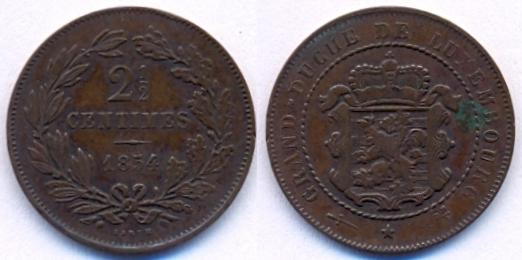 |
KM#21 2½ centimes. Year:
1854. Weight:
2.52g. Metal:
Bronze. Edge:
Plain. Diameter:
20.50 mm.
Thickness: 1.0
mm.
Alignment:
Coin. Mint:
Utrecht (mint marks Sword and Caduceus).
Obverse: "2½ CENTIMES" and date, divided by a
line in the center, surrounded by wreath. "BARTH"
(François Barth-Wahl) designer initials
at
the bottom. |
|
Reverse:
Luxembourg Coats And Arms in center circle. "GRAND-DUCHE DE
LUXEMBOURG" around the center circle. One star at the bottom with
mintmarks on both sides of it. Mintage:
N/A.
Minted Years: 1854 with É
in DUCHÉ, 1854 with E in DUCHE, 1870 with dot below BARTH, 1870
without dot below BARTH, 1901 with BARTH, 1901 with BAPTH and 1908. |
|
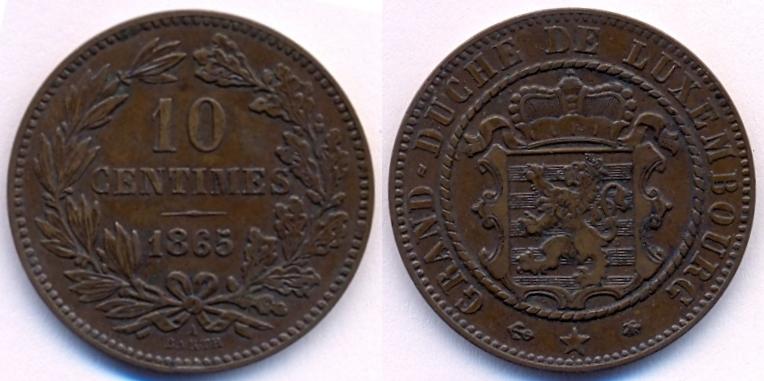 |
KM#23.2 10 centimes. Year:
1865. Weight:
10.09g. Metal:
Bronze. Edge:
Plain. Diameter:
30.50 mm.
Thickness: 1.5
mm.
Alignment:
Coin. Mint:
Paris (mint marks "A" on obverse side with
Anchor and Bee on the reverse side).
Obverse: "10 CENTIMES" and date, divided by a
line in the center, surrounded by wreath. "A" mintmark and "BARTH"
(François Barth-Wahl) designer initials at the bottom. |
|
Reverse:
Luxembourg Coats And Arms in center circle. "GRAND-DUCHÉ DE
LUXEMBOURG" around the center circle. One star at the bottom with
mintmarks on both sides of it. Mintage:
1,000,000.
Minted Years: 1855, 1860
and 1865. Note:
Even on the Netherlands coins in silver, dated 1818-1874, Luxembourg
was mentioned on them. For example: WILLEM III KONING DER
NED[ERLANDEN] G[ROOT] H[ERTOG] V[AN] L[UXEMBURG] which meant in
English, "William III, King of the Netherlands and Grand Duke of
Luxembourg. |
|
| |
| |
- NASSAU-WEILBURG
- Under the 1783 Nassau Family Pact, those
territories of the Nassau family in the Holy Roman Empire at the time of
the Pact (Luxembourg and Nassau) were bound by semi-Salic law, which
allowed inheritance by females or through the female line only upon
extinction of male members of the dynasty. When William III died leaving
only his daughter Wilhelmina as an heir, the crown of the Netherlands,
not being bound by the family pact, passed to Wilhelmina. However, the
crown of Luxembourg passed to a male of another branch of the House of
Nassau: Adolphe, the dispossessed Duke of Nassau and head of the branch
of Nassau-Weilburg.
- Adolphe S/o
Guillaume......................23
Nov 1890 - 17 Nov 1905
- Adolf Wilhelm August Karl Friedrich was a son
of William, Duke of Nassau (1792–1839) and his first wife Princess
Louise of Saxe-Hildburghausen. Adolphe's half-sister, Sophia of Nassau,
was the wife of Oscar II of Sweden. Adolf was Duke
of Nassau 1839-1866.
- Guillaume IV (regent).................14
Apr 1902 - 17 Nov 1905
- Guillaume IV S/o Adolphe (continued).......17
Nov 1905 - 25 Feb 1912
- At the death of his uncle, Prince Nikolaus-Wilhelm
in 1905, the only other legitimate male in the House of Nassau-Weilburg
was William's cousin, Georg Nikolaus, Count of Merenberg, the product of
a morganatic marriage. So in 1907, William declared the Counts of
Merenberg non-dynastic, naming his own eldest daughter Marie-Adélaïde
(1894–1924) as heiress-presumptive to the grand ducal throne. She became
Luxembourg's first reigning female monarch upon her father's death in
1912, and upon her own abdication in 1919, was succeeded by her younger
sister Charlotte (1896–1985).
- Marie Anne de
Bragança (fem.
regent)..19
Mar 1908 - 25 Feb 1912 d. 1942
- Infanta Marie Anne of Portugal was the
daughter of the usurper-king Miguel I of Portugal and wife of
Guillaume IV, Grand Duke of Luxembourg. The couple had six daughters
and no sons. She died on 31 July 1942.
- Marie-Adélaïde D/o Guillaume IV (female)...25
Feb 1912 - 15 Jan 1919 d. 1924
- Maria Adelheid Theresia Hilda Antonia
Wilhelmina remained unmarried and childless. Marie-Adélaïde ruled for
less than 7 years and due to her unpopularity, she was forced to
abdicate in favour of her sister Grand Duchess Charlotte.
- Marie Anne de
Bragança (fem.
regent)..25
Feb 1912 - 14 Jun 1912
-
Germany....................................02 Aug 1914 - 20 Nov 1918
- German
Military Commanders
- Albrecht Maria
Alexander Herzog von Württemberg.02 Aug 1914 - 22 Jan 1915
- Richard Karl von
Tessmar........................22 Jan 1915 - 20 Nov 1918
- Attempts to
Establish a Republic in Luxembourg 1918-1919
- The end of World War I was followed by at
chaotic period, as several groups, having different points of view on
the status of post-war Luxembourg opposed each other (partisans of the
reigning Grand Duchess of the House of Nassau, of forming a republic,
and of annexation to Belgium or France).
- First attempt to create a republic at
Luxembourg on 09 Nov 1918 (hours) by Luxembourg-City Committee.
- Aloys Kaiser
- Émile Mark
- Jean Schaak
- Second republic revolt at Esch-sur-Alzette on
11 Nov 1918 (hours) by Esch-sur-Alzette Committee.
- Pierre Kappweiler
- Jacques Tillmany
- Pierre Schaak
- Some members of the Luxembourgian Chamber
declare the House of Nassau deposed and that a Committee of Public
Safety (Comité de Salut Public) will govern the "republic."
- Émile Servais (Chairman).........10
Jan 1919 - 11 Jan 1919 d.1928
- On 11 Jan 1919, Chamber members were dispersed
by French troops.
- Charlotte D/o Guillaume IV (1st time)......15
Jan 1919 - 10 May 1940 d. 1985
- Charlotte Adelgonde Élise/Elisabeth Marie
Wilhelmine married her first cousin Prince Felix of Bourbon-Parma, a son
of Marie Anne's younger sister. Charlotte was in exile from 10 May 1940 - Aug 1940 in France,
Aug 1940 - 04 Oct 1940 in London, 04 Oct 1940 - Nov 1940 in New York and
Nov 1940 - 14 Apr 1945 in Montreal.
- Germany....................................10 May 1940 - 11 Sep 1944
-
German Military Commanders
- Karl Rudolf
Gerd von Rundstedt........10 May 1940 - 22 May 1940
- Otto Gullmann
(acting)
...............22 May 1940 - 24 May 1940
- Friedrich
Schumacher (acting).........25
May 1940 - 04 Jun 1940
-
Military Governor
- Alexander
Freiherr von Falkenhausen...04 Jun 1940 - 06 Aug 1940
-
Chief of civil administration (from Aug 30 1942, also Gauleiter of
Moselland)
- Gustav Simon (fled
1-3 Sep 1944)......07
Aug 1940 - 11 Sep 1944
- Curt Souchay (acting
for Simon).......01
Sep 1944 - 03 Sep 1944
- President of UNION
(Resistance Force)
- François Schammel............................1944
- 1945
- On 23 Mar 1944, Letzeburger Patriote Liga,
Letzeburger Róde Léf and Letzeburger Volléks-Legóin resistance
movements, set up previously, unite into a new organization called
Unión vun de Letzeburger Freihéts-organisation (UNION). On 23 Mar
1944, Letzeburger Patriote Liga, Letzeburger Róde Léf and
Letzeburger Volléks-Legóin resistance movements, set up previously,
unite into a new organization called Unión vun de Letzeburger
Freihéts-organisation (UNION). On 01 Sep 1944, Letzeburger
Freihéts-Bewegong joins UNION.
- Allied Forces
Occupation...................11 Sep 1944 - 12 Apr 1945
- Allied Regional
Military Government Officers, Luxembourg (all from U.S.)
- Charles William Matthews (1st
time)...13 Sep 1944 - 16 Sep 1944
- Edgar Alonzo Jett
II..................16 Sep 1944 - 13 Nov 1944
- Charles William Matthews (2nd
time)...13 Nov 1944 - 23 Apr 1945
- Charlotte D/o Guillaume IV (2nd time)......12
Apr 1945 - 12 Nov 1964 d. 1985
- Jean (regent).........................04
May 1961 - 12 Nov 1964
|
| |
| |
|
Coins of Adolphe (1901) |
|
Monetary standard:
Franc = 100 centimes. |
1 Luxembourg franc was equal to 1 Belgian franc. Belgian francs
were legal tender inside Luxembourg, and Luxembourg francs were
legal tender in Belgium.
|
| |
|
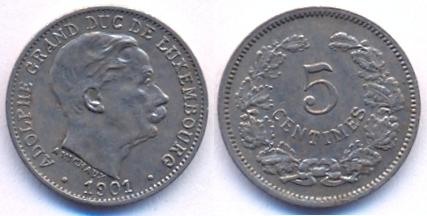 |
KM#24 5 centimes. Year:
1901. Weight:
2.05g [2.00g]. Metal:
Copper-Nickel. Edge:
Plain. Diameter:
17.00 mm.
Thickness: 1.15
mm.
Alignment:
Coin. Mint:
N/A.
Obverse: Adolphe's portrait in center facing
right. "ADOLPHE GRAND DUC DE LUXEMBOURG" written around. "A MICHAUX"
(Alphonse Michaux)
designer's name below his neck. Date at the bottom.
Reverse:
Value "5 CENTIMES" in the center, surrounded by wreath. Mintage:
2,000,000.
Minted Years: One year
type. |
|
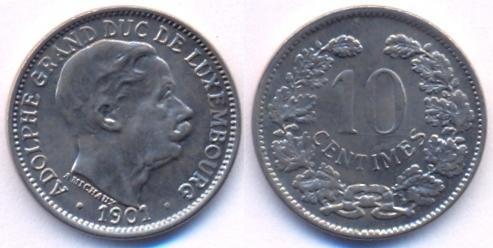 |
KM#25 10 centimes. Year:
1901. Weight:
3.03g [3.00g]. Metal:
Copper-Nickel. Edge:
Plain. Diameter:
20.00 mm.
Thickness: 1.3
mm.
Alignment:
Coin. Mint:
N/A.
Obverse: Adolphe's portrait in center facing
right. "ADOLPHE GRAND DUC DE LUXEMBOURG" written around. "A MICHAUX"
(Alphonse Michaux)
designer's name below his neck. Date at the bottom.
Reverse:
Value "10 CENTIMES" in the center, surrounded by wreath. Mintage:
4,000,000.
Minted Years: One year
type. |
|
| |
| Coins of
Guillaume IV
(1908) |
|
Monetary standard:
Franc = 100 centimes. |
| |
|
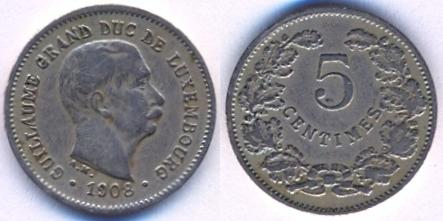 |
KM#26 5 centimes. Year:
1908. Weight:
2.47g [2.50g]. Metal:
Copper-Nickel. Edge:
Plain. Diameter:
18.00 mm.
Thickness: 1.5
mm.
Alignment:
Coin. Mint:
N/A.
Obverse: Adolphe's portrait in center facing
right. "GUILLAUME GRAND DUC DE LUXEMBOURG" written around. "A.M."
(Alphonse Michaux) designer's initials below his neck. Date at the bottom.
Reverse:
Value "5 CENTIMES" in the center, surrounded by wreath. Mintage:
1,500,000.
Minted Years: One year
type. |
|
| |
| Coins of Marie-Adélaïde
(1915-1916 + 1917 Pattern issues) |
|
Monetary standard:
Franc = 100 centimes. |
| |
|
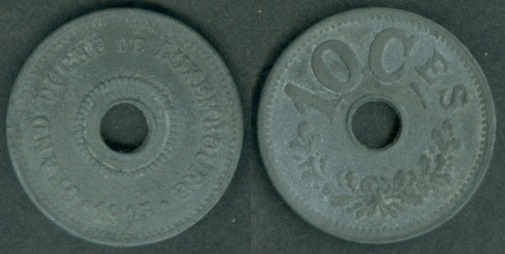 |
KM#28 10 centimes. Year:
1915. Weight:
3.00g [3.00g]. Metal:
Zinc. Edge:
Plain. Diameter:
20.00 mm.
Thickness: 2.10
mm.
Alignment:
Coin. Mint:
N/A.
Obverse:
Beaded circle around hole in center. "GRAND DUCHÉ DE LUXEMBOURG" written around
the center hole. Beaded circle around the hole. Date at the bottom.
Reverse:
Value "10 CES" above the center hole. Wreath at the bottom. Mintage:
1,400,000.
Minted Years: One year
type. |
|
 |
KM#29 25 centimes. Year:
1916. Weight:
4.88g [5.00g]. Metal:
Zinc. Edge:
Plain. Diameter:
23.90 mm.
Thickness: 2.10
mm.
Alignment:
Coin. Mint:
N/A.
Obverse:
Beaded circle around hole in center. "GRAND DUCHÉ DE LUXEMBOURG" written around
the center hole. Beaded circle around the hole. Date at the bottom.
Reverse:
Value "25 CES" above the center hole. Wreath at the bottom. Mintage:
800,000.
Minted Years: 1916 and
1920 (1920 issue is very costly). |
|
| |
|
Coins of Charlotte (1918-1964) |
|
Monetary standard:
Franc = 100 centimes. |
| |
|
1918 |
| Although Charlotte started to rule
from January 1919, but 1918 issues are considered on her name. |
| |
|
 |
KM#31 10 centimes. Year:
1918. Weight:
3.23g [3.20g]. Metal:
Iron. Edge:
Plain. Diameter:
20.00 mm.
Thickness: 1.59
mm.
Alignment:
Coin. Mint:
N/A.
Obverse:
Luxembourg emblem in the center. "GRAND DUCHÉ DE LUXEMBOURG" written around. Date at the bottom.
Reverse:
Value "10 CES" in the center, surrounded by wreath. Mintage:
1,603,000.
Minted Years: 1918, 1921
and 1923. |
|
| |
|
1922 |
| |
|
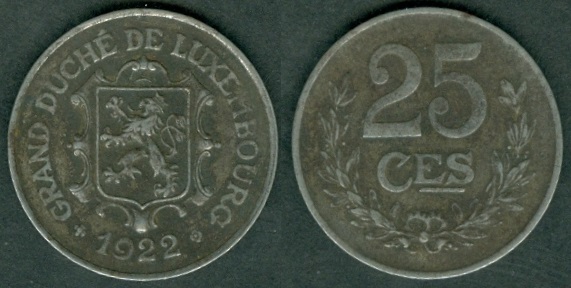 |
KM#32 25 centimes. Year:
1922. Weight:
3.88g [3.85g]. Metal:
Iron. Edge:
Plain. Diameter:
23.00 mm.
Thickness: 1.59
mm.
Alignment:
Medal. Mint:
N/A.
Obverse:
Luxembourg emblem in the center. "GRAND DUCHÉ DE LUXEMBOURG" written around. Date at the bottom.
Reverse:
Value "25 CES" in the center, surrounded by wreath. Mintage:
600,000.
Minted Years: 1919, 1920
and 1922. |
|
| |
|
1924 |
| |
|
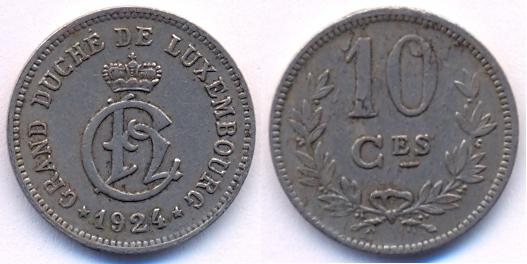 |
KM#34 10 centimes. Year:
1924. Weight:
3.99g. Metal:
Copper-Nickel. Edge:
Plain. Diameter:
21.00 mm.
Thickness: 1.5
mm.
Alignment:
Coin. Mint:
N/A.
Obverse: Charlotte's crowned monogram in the
center. "GRAND DUCHÉ DE LUXEMBOURG" written around. Date
at the bottom. |
|
Reverse:
Value "10" at the top. "CES" written below it, surrounded by wreath. Mintage:
3,500,000.
Minted Years: One year
type. Engraver:
Jean Mich. |
|
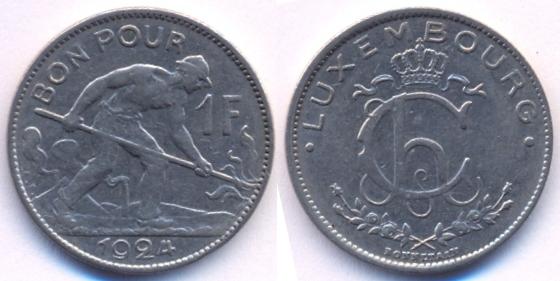 |
KM#35 1 Franc. Year:
1924. Weight:
5.00g. Metal:
Nickel. Edge:
Reeded. Diameter:
23.00 mm.
Thickness: 2.0
mm.
Alignment:
Coin. Mint:
N/A.
Obverse: "BON POUR" (Good For) in French at top
left side. Man working in the field in the center. "1F" written on
his right side. Date at the bottom. |
|
Reverse: "LUXEMBOURG" written at the
top. Charlotte's crowned monogram in the center with Wreath below
it. "BONNETAIN" designer's name written at the bottom. Mintage:
1,000,000.
Minted Years: 1924, 1928
and 1935. Engraver:
Armand Bonnetain. |
|
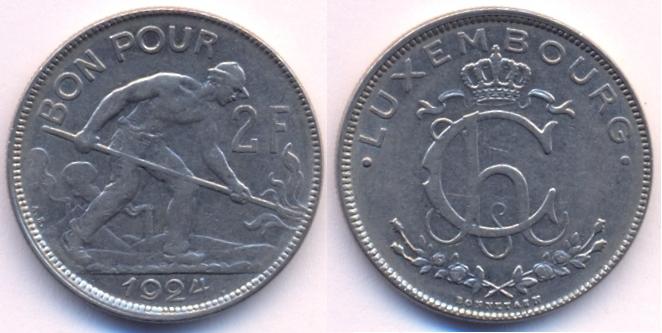 |
KM#36 2 Francs. Year:
1924. Weight:
9.98g. Metal:
Nickel. Edge:
Reeded. Diameter:
26.50 mm.
Alignment:
Coin. Mint:
N/A.
Obverse: "BON POUR" (Good For) in French at top
left side. Man working in the field in the center. "2F" written on
his right side. Date at the bottom. |
|
Reverse: "LUXEMBOURG" written at the
top. Charlotte's crowned monogram in the center with Wreath below
it. "BONNETAIN" designer's name written at the bottom. Mintage:
1,000,000.
Minted Years: One year
type. Engraver:
Armand Bonnetain. |
|
| |
|
1927 |
| |
|
 |
KM#37 25 centimes. Year:
1927. Weight:
5.60g. Metal:
Copper-Nickel. Edge:
Plain. Diameter:
24.50 mm.
Thickness:
1.4 mm
Alignment:
Coin. Mint:
N/A.
Obverse: Value "25 CTS" and date at the right side.
Sprig on the left side. "EVERAERTS" designer's name written at the bottom.
Reverse:
Luxembourg emblem in the center with one star on each side. "LUXEMBOURG" written at the bottom.
Mintage:
2,500,000.
Minted Years: One year
type. Engraver:
Alexandre Everaerts. |
|
| |
|
1928 |
| |
|
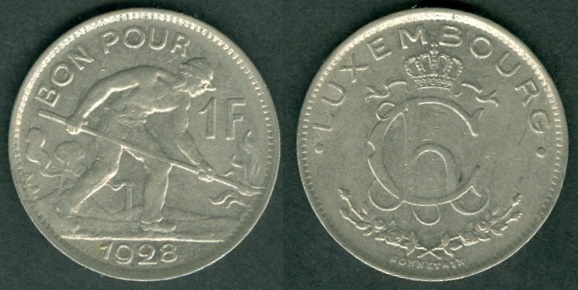 |
Same as above coin KM#35, but slightly rotated and... Year:
1928. Weight:
4.91g.
Alignment:
Coin. Mintage:
2,000,000. |
|
| |
|
1929 |
| |
|
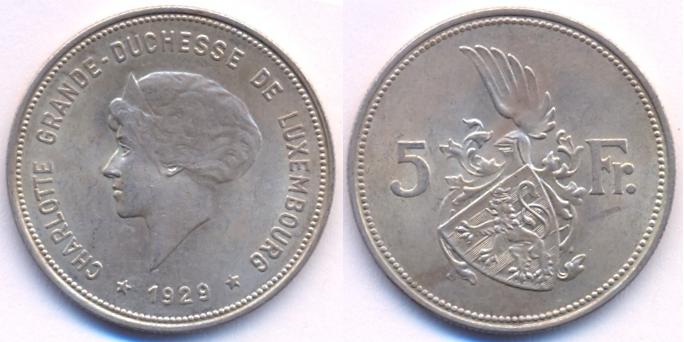 |
| KM#38 5 Francs. Year:
1929. Weight:
7.95g [8.00g]. Metal:
0.625 Silver. Edge:
Reeded. Diameter:
28.00 mm.
Thickness: 2.0
mm.
Alignment:
Coin. Mint:
N/A.
Obverse: Charlotte's portrait facing left in
the center. "CHARLOTTE GRANDE-DUCHESSE DE LUXEMBOURG" written around
her. Date at the bottom with one star on each side.
Reverse:
Winged Luxembourg emblem in the center, which divides Value "5 Fr.". Mintage:
2,000,000.
Minted Years: One year
type. Engraver:
Roessler. |
|
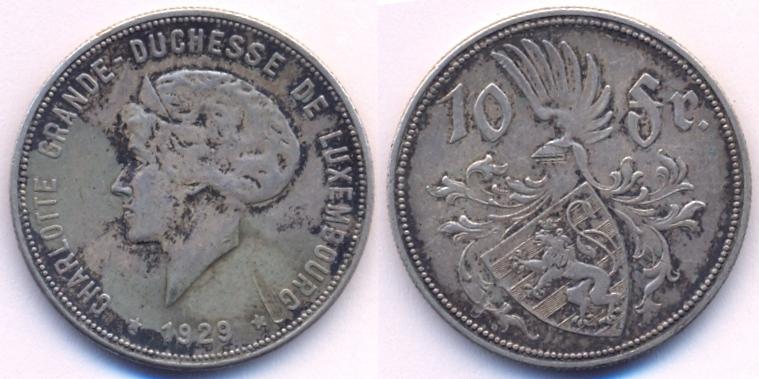 |
| KM#39 10 Francs. Year:
1929. Weight:
13.26g [13.50g]. Metal:
0.750 Silver. Edge:
Reeded. Diameter:
30.50 mm.
Thickness: 2.0
mm.
Alignment:
Coin. Mint:
N/A.
Obverse: Charlotte's portrait facing left in
the center. "CHARLOTTE GRANDE-DUCHESSE DE LUXEMBOURG" written around
her. Date at the bottom with one star on each side.
Reverse:
Winged Luxembourg emblem in the center, which divides Value "10 fr.". Mintage:
1,000,000.
Minted Years: One year
type. Engraver:
Roessler. |
|
| |
|
1930 |
| |
|
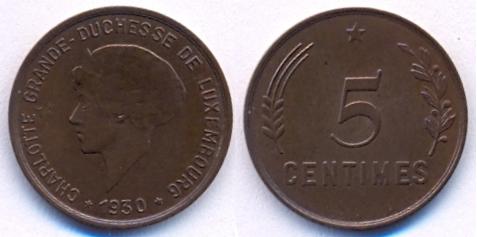 |
KM#40 5 centimes. Year:
1930. Weight:
2.44g [2.50g]. Metal:
Bronze. Edge:
Plain. Diameter:
19.00 mm.
Thickness: 1.24
mm.
Alignment:
Coin. Mint:
N/A.
Obverse: Charlotte's portrait facing left in
the center. "CHARLOTTE GRANDE-DUCHESSE DE LUXEMBOURG" written around
her. Date at the bottom with one star on each side. |
|
Reverse: One star at the top. Numeral "5" in
the center with "CENTIMES" written below it.
Different sprig on each side. Mintage:
5,000,000.
Minted Years: One year
type. Engraver:
Roessler. |
|
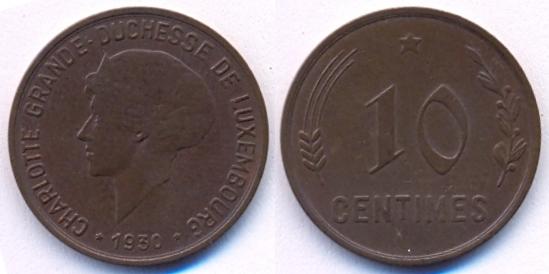 |
KM#41 10 centimes. Year:
1930. Weight:
3.95g [4.00g]. Metal:
Bronze. Edge:
Plain. Diameter:
22.00 mm.
Alignment:
Coin. Mint:
N/A.
Obverse: Charlotte's portrait facing left in
the center. "CHARLOTTE GRANDE-DUCHESSE DE LUXEMBOURG" written around
her. Date at the bottom with one star on each side. |
|
Reverse: One star at the top. Numeral "10" in
the center with "CENTIMES" written below it.
Different sprig on each side. Mintage:
5,000,000.
Minted Years: One year
type. Engraver:
Roessler. |
|
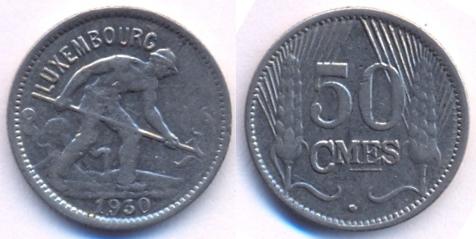 |
KM#43 50 centimes. Year:
1930. Weight:
3.04g. Metal:
Nickel. Edge:
Reeded. Diameter:
19.00 mm.
Alignment:
Coin. Mint:
N/A.
Obverse: "LUXEMBOURG" at top
left side. Man working in the field in the center. Date at the bottom.
Reverse: "50 CMES" written in the
center. Wheat stack on both sides. Dot at the bottom. Mintage:
2,000,000.
Minted Years: One year
type. Engraver:
Armand Bonnetain. |
|
| |
|
1935 |
| |
|
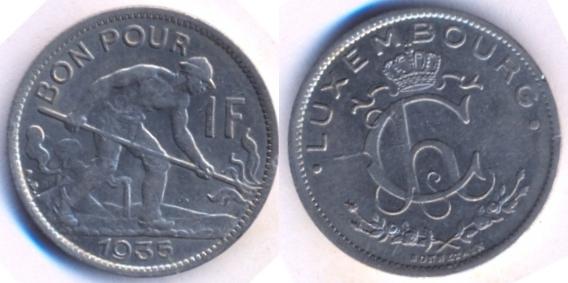 |
Same as above coin KM#35, but slightly rotated and... Year:
1935. Weight:
4.97g.
Alignment:
Coin. Mintage:
1,000,000. |
|
| |
|
1939 |
|
|
|
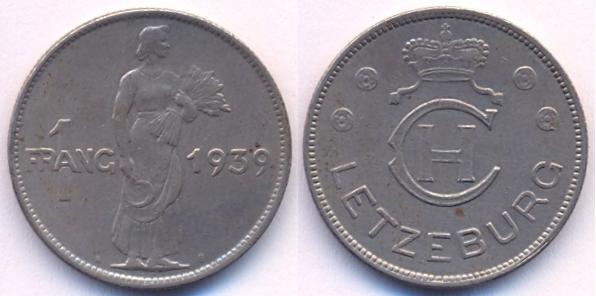 |
KM#44 1 Franc. Year:
1939. Weight:
6.55g. Metal:
Copper-Nickel. Edge:
Reeded. Diameter:
24.00 mm.
Thickness: 2.00
mm.
Alignment:
Coin. Mint:
N/A.
Obverse: A woman figure standing, looking right
and carrying wheat stacks in her left arm. "FRANC" super imposed on
numeral "1" on her left side. Date at her right side.
Reverse: Charlotte's crowned monogram in the center with
two circular designs on each side. "LETZEBURG" written at the bottom. Mintage:
5,000,000.
Minted Years: One year
type. Engraver:
Armand Bonnetain. |
|
|
|
|
1946 |
|
|
|
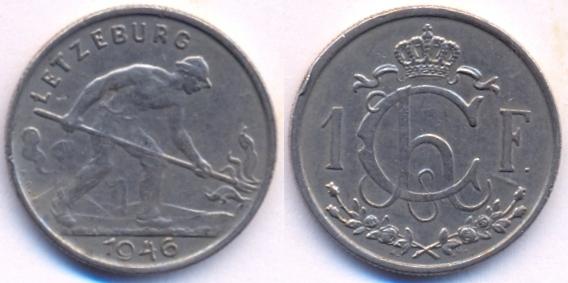 |
KM#46.1 1 Franc. Year:
1946. Weight:
5.07g [5.00g]. Metal:
Copper-Nickel. Edge:
Reeded. Diameter:
22.50 mm.
Thickness: 1.70
mm.
Alignment:
Coin. Mint:
N/A.
Obverse: "LETZEBURG" at top
left side. Man working in the field in the center. Date at the bottom.
Reverse: "Charlotte's crowned monogram in the center.
Numeral "1" on the left side and "F" on the right side. Wreath at the bottom. Mintage:
4,000,000.
Minted Years: 1946 and
1947. Engraver:
Armand Bonnetain. |
|
|
|
|
1947 |
|
|
|
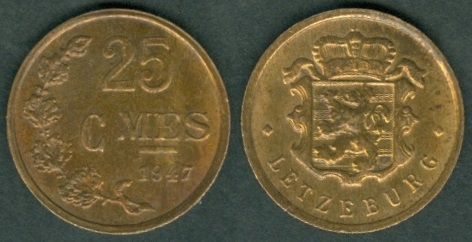 |
KM#45 25 centimes. Year:
1947. Weight:
2.53g. Metal:
Bronze. Edge:
Plain. Diameter:
19.00 mm.
Thickness: 1.29
mm
Alignment:
Coin. Mint:
N/A.
Obverse: Value "25 CMES" and date at the
bottom right side.
Sprig on the left side.
Reverse:
Luxembourg emblem in the center with one star on each side. "LETZEBURG" written at the bottom. Mintage:
1,000,000.
Minted Years: 1946 and
1947.
Engraver: Julien
and Nina Lefèvre. |
|
|
|
|
1949 |
|
|
|
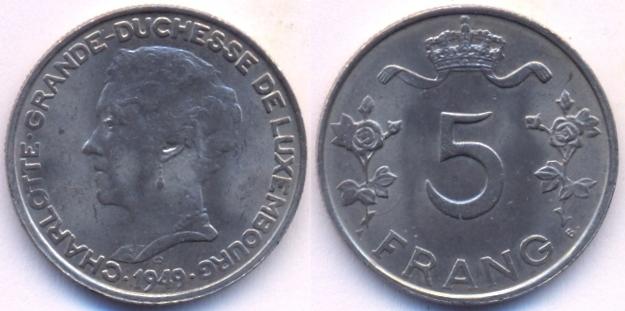 |
KM#50 5 Francs. Year:
1949. Weight:
7.06g [7.00g]. Metal:
Copper-Nickel. Edge:
Reeded. Diameter:
25.50 mm.
Thickness: 1.90
mm.
Alignment:
Coin. Mint:
N/A.
Obverse: Charlotte's portrait facing left in
the center. "CHARLOTTE · GRANDE-DUCHESSE DE LUXEMBOURG" written around
her. Date at the bottom with one star on each side.
Reverse:
Numeral value "5" in the center, flanked by flowers below crown and
ribbon "FRANG" written at the bottom. Mintage:
2,000,000.
Minted Years: One year
type. Engraver:
Armand Bonnetain. |
|
|
|
|
1952 |
|
|
|
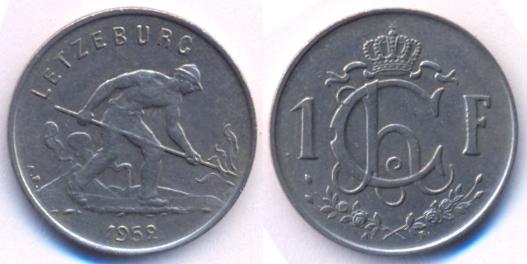 |
KM#46.2 1 Franc. Year:
1952. Weight:
4.01g. Metal:
Copper-Nickel. Edge:
Reeded. Diameter:
21.00 mm.
Thickness: 1.60
mm.
Alignment:
Coin. Mint:
N/A.
Obverse: "LETZEBURG" at top
left side. Man working in the field in the center. Date at the bottom. |
|
Reverse: "Charlotte's crowned monogram in the center.
Numeral "1" on the left side and "F" on the right side. Wreath at the bottom. Mintage:
5,000,000.
Minted Years: 1952, 1953,
1955, 1957, 1960, 1962 and 1964. Engravers:
Armand Bonnetain ("A.B." written on
the obverse side near the right root of the man close to the edge of
the coin) |
|
|
|
|
1953 |
|
|
|
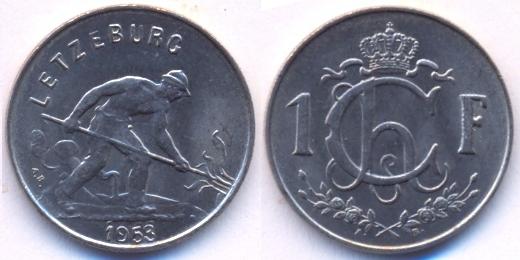 |
Same as above coin KM#46.2, but... Year:
1953. Weight:
4.04g. Mintage:
2,000,000. |
|
|
|
|
1954 |
|
|
|
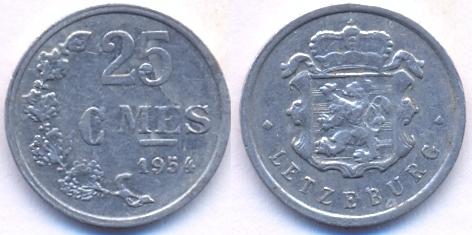 |
KM#45a.1 25 centimes. Year:
1954. Weight:
0.76g. Metal:
Aluminum. Edge:
Plain. Diameter:
18.50 mm.
Thickness: 1.29
mm.
Alignment:
Coin. Mint:
N/A.
Obverse: Value "25 CMES" and date at the
bottom right side.
Sprig on the left side.
Reverse:
Luxembourg emblem in the center with one star on each side. "LETZEBURG" written at the bottom. Mintage:
7,000,000.
Minted Years: 1954, 1957,
1960, 1963, 1965, 1967, 1968, 1970 and 1972.
Engraver: Julien
and Nina Lefèvre. |
|
Note: The coins also exists in Medal
alignment as KM#45a.2 produced in 1954, 1960, 1963 and 1967. |
|
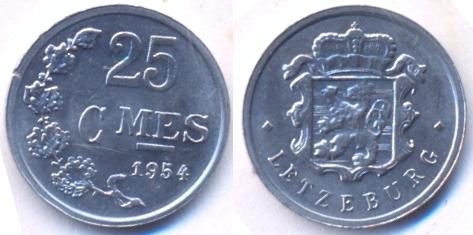 |
Same as above coin KM#45a.1 and year, but slightly rotated from
obverse side as shown. Weight:
0.75g. |
|
|
|
|
1957 |
|
|
|
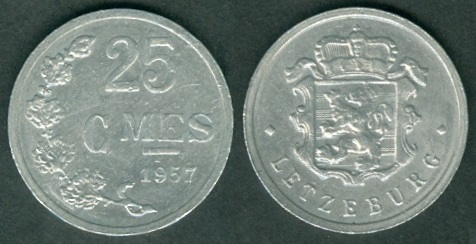 |
Same as above coin KM#45a.1, but... Year:
1957. Weight:
0.77g.
Alignment:
Coin. Mintage:
3,020,000. |
|
|
|
|
1960 |
|
|
|
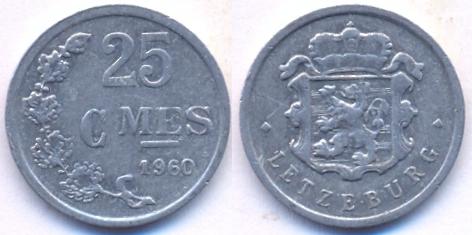 |
Same as above coin KM#45a.1, but... Year:
1960. Weight:
0.75g.
Alignment:
Coin. Mintage:
3,020,000. |
|
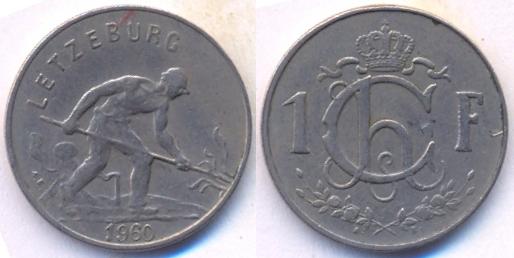 |
Same as above coin KM#46.2, but... Year:
1960. Weight:
4.11g. Mintage:
2,000,000. |
|
|
|
|
1962 |
|
|
|
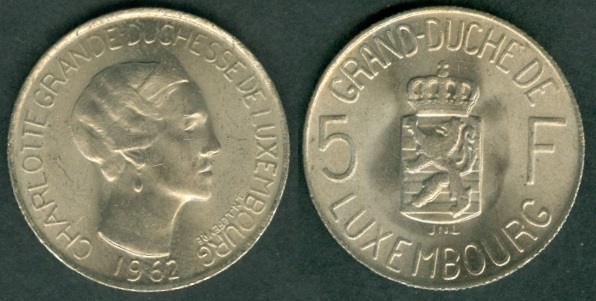 |
KM#51 5 Francs. Year:
1962. Weight:
6.16g. Metal:
Copper-Nickel. Edge:
Reeded. Diameter:
24.00 mm.
Thickness: 1.80
mm.
Alignment:
Coin. Mint:
N/A.
Obverse: Charlotte's portrait facing right in
the center. "CHARLOTTE GRANDE-DUCHESSE DE LUXEMBOURG" written around
her. Date at the bottom "J.N.
LEFEVRE" written below "BOURG" clockwise. |
|
Reverse:
"GRANDE-DUCHESSE DE" written at the top.
Luxembourg emblem in the center. "5" written on the left side and
"F" on the right side. "LUXEMBOURG" written at the bottom. Mintage:
2,000,000.
Minted Years: One year
type.
Engraver: Julien
and Nina Lefèvre. |
|
|
|
|
1963 |
|
|
|
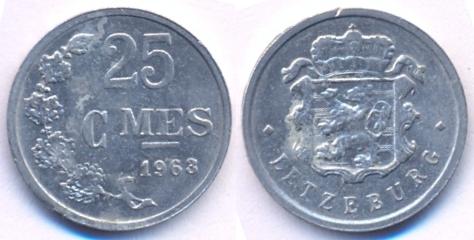 |
Same as above coin KM#45a.1, but... Year:
1963. Weight:
0.78g.
Alignment:
Coin. Mintage:
4,000,000. |
|
| |
|
1964 |
| |
|
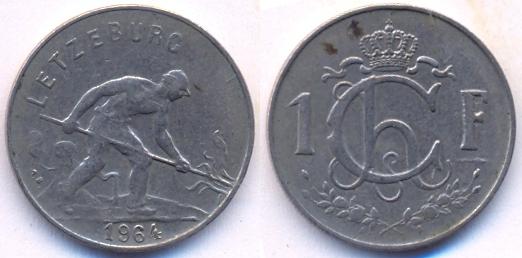 |
Same as above coin KM#46.2, but... Year:
1964. Weight:
4.02g. Mintage:
2,000,000. |
|
| |
| |
- CAPET-Bourbon-Spain-Parma
- Jean S/o Félix (continued).................12
Nov 1964 - 07 Oct 2000
- Jean Benoît Guillaume Robert Antoine Louis
Marie Adolphe Marc d'Aviano was the son of Prince Felix of Bourbon-Parma
and Charlotte, Grand Duchess of Luxembourg. Among his godparents was
Pope Benedict XV, who gave him his second name. He abdicated on 07
October 2000, and was succeeded on the throne by his son Henri.
- Henri (regent)........................04
Mar 1998 - 07 Oct 2000
- Henri S/o Jean (continued).................07
Oct 2000 - date
- Henri Albert Gabriel Félix Marie Guillaume is
the eldest son of Jean, Grand Duke of Luxembourg and Princess Joséphine-Charlotte
of Belgium. His maternal grandparents were King Leopold III of Belgium
and Astrid of Sweden. He is a nephew of the current King of the
Belgians, Albert II.
|
| |
| |
|
Coins of Jean (1965-2000) |
|
Monetary standard:
Franc = 100 centimes. |
| Jean portrait
on the francs showed him facing to the left as Charlotte. Usually successive
monarchs alternate the direction they faced on coins but this was not in his
case. |
| |
|
1965 |
| |
|
 |
Same as above coin KM#45a.1, but... Year:
1965. Weight:
0.78g.
Alignment:
Coin. Mintage:
2,000,000. |
|
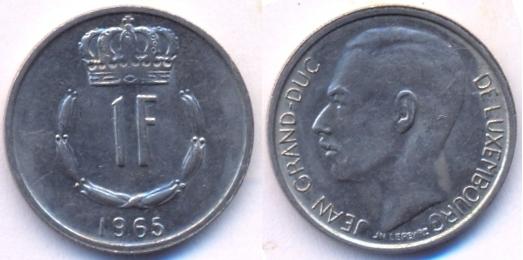 |
KM#55 1 Franc. Year:
1965. Weight:
4.02g. Metal:
Copper-Nickel. Edge:
Reeded. Diameter:
21.00 mm.
Thickness: 1.62
mm.
Alignment:
Coin. Mint:
N/A.
Obverse: Crown at the top. Value "1F"
in the center with wreath below it. Date at the bottom.
Reverse:
Jean's portrait, facing left in the center. "JEAN GRAND-DUC"
on the left side clockwise and "DE LUXEMBOURG" at the right side
clockwise. "J.N. LEFEVRE"
designer's name written at the bottom. Mintage:
3,000,000.
Minted Years: 1965, 1966,
1968, 1970, 1972, 1973 and 1976-1984.
Engraver: Julien and Nina Lefèvre. |
|
| |
|
1967 |
| |
|
 |
Same as above coin KM#45a.1, but... Year:
1967. Weight:
0.77g.
Alignment:
Coin. Mintage:
3,000,0000. |
|
| |
|
1968 |
| |
|
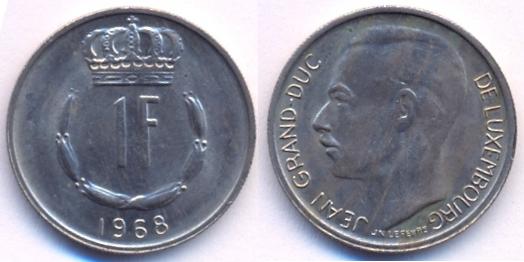 |
Same as above coin KM#55, but... Year:
1968. Weight:
4.00g. Mintage:
3,000,000. |
|
| |
|
1970 |
| |
|
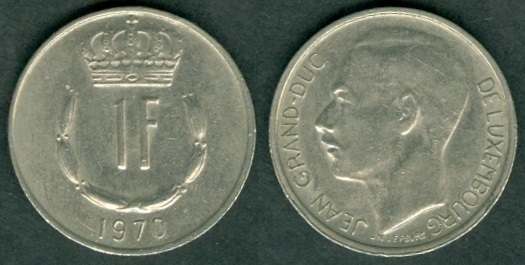 |
Same as above coin KM#55, but... Year:
1970. Weight:
4.02g. Mintage:
3,000,000. |
|
| |
|
1971 |
| |
|
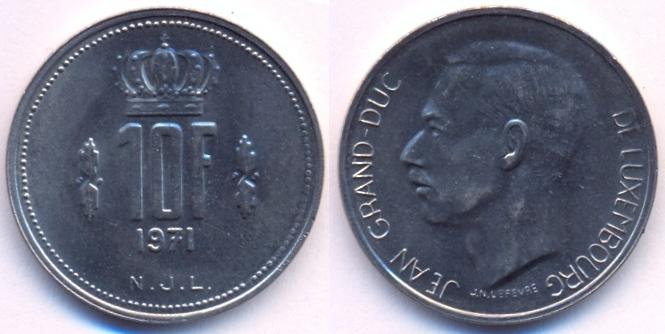 |
| KM#57 10 Francs. Year:
1971. Weight:
7.95g. Metal:
Nickel. Edge:
Plain. Diameter:
27.00 mm.
Thickness: 1.92
mm.
Alignment:
Coin. Mint:
N/A.
Obverse: Crown at the top. Value "10F"
in the center with design on both sides. Date below the value. "N.J.L."
written at the bottom.
Reverse:
Jean's portrait, facing left in the center. "JEAN GRAND-DUC"
on the left side clockwise and "DE LUXEMBOURG" at the right side
clockwise. "J.N. LEFEVRE"
designer's name written at the bottom. Mintage:
3,000,000.
Minted Years: 1971, 1972,
1974 and 1977-1980. Engraver:
Julien and Nina Lefèvre. Note:
Stylish 7 in the year. |
|
| |
|
1972 |
| |
|
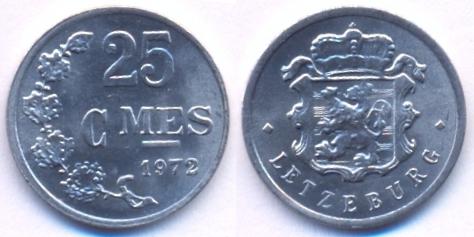 |
Same as above coin KM#45a.1, but... Year:
1972. Weight:
0.78g.
Alignment:
Coin. Mintage:
4,000,000. |
|
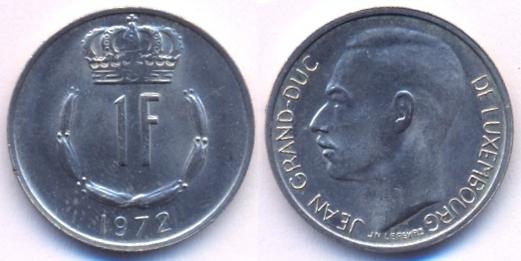 |
Same as above coin KM#55, but... Year:
1972. Weight:
4.02g. Mintage:
3,000,000. |
|
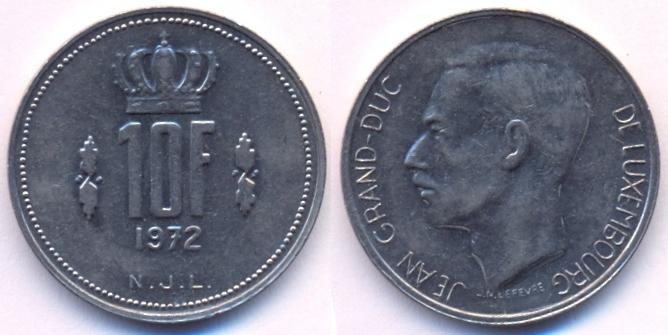 |
| Same as above coin KM#57, but... Year:
1972. Weight:
8.11g. Mintage:
3,000,000. |
|
| |
|
1974 |
| |
|
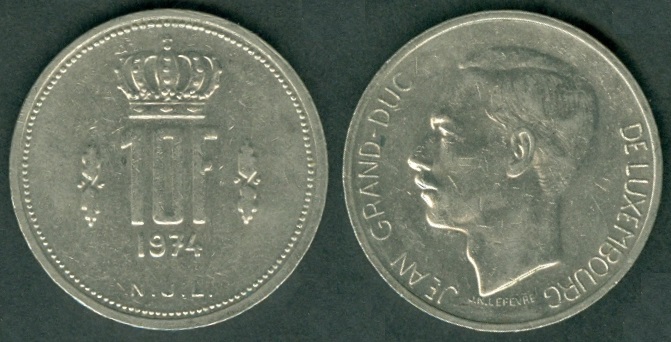 |
| Same as above coin KM#57, but... Year:
1974. Weight:
7.97g. Mintage:
3,000,000. |
|
| |
|
1976 |
| |
|
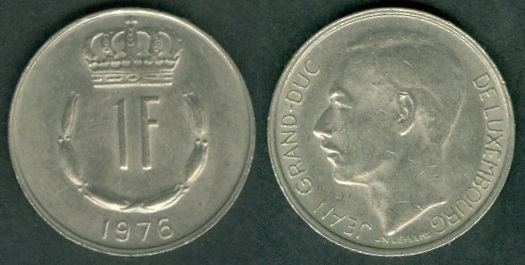 |
Same as above coin KM#55, but... Year:
1976. Weight:
4.05g. Mintage:
3,000,000. |
|
| |
|
1977 |
| |
|
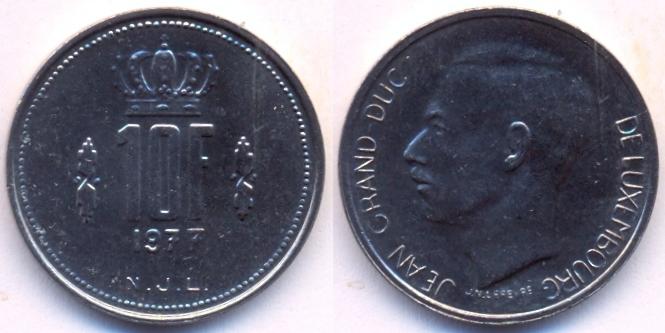 |
| Same as above coin KM#57, but... Year:
1972. Weight:
8.04g. Mintage:
1,000,000. |
|
| |
|
1978 |
| |
|
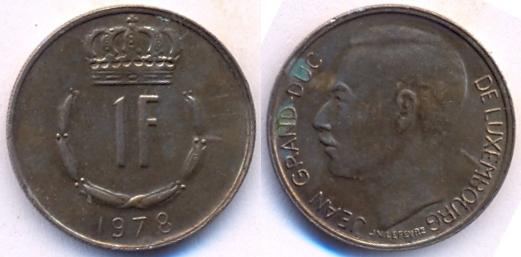 |
Same as above coin KM#55, but... Year:
1978. Weight:
4.00g. Mintage:
3,000,000. |
|
| |
|
1980 |
| |
|
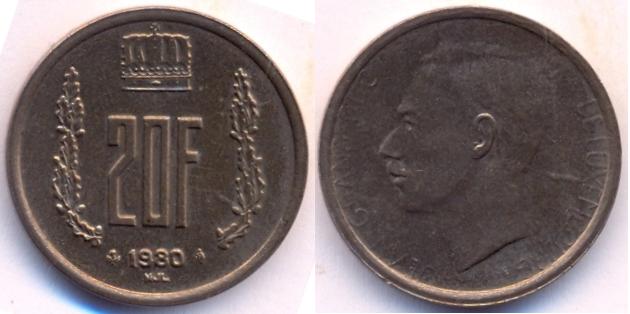 |
KM#58 20 Francs. Year:
1980. Weight:
8.49g. Metal:
Bronze. Edge:
Decorative. Diameter:
25.50 mm.
Thickness: 2.33
mm.
Alignment:
Coin. Mint:
N/A.
Obverse: Crown at the top. Value "20F" in the center.
Sprigs on both sides. Date below the value. "NJL" written
at the bottom. |
|
Reverse:
Jean's portrait, facing left in the center. "JEAN GRAND-DUC"
on the left side clockwise and "DE LUXEMBOURG" at the right side
clockwise. "J.N. LEFEVRE"
designer's name written at the bottom. Mintage:
3,000,000.
Minted Years: 1980-1983.
Engraver: Julien
and Nina Lefèvre.
Note: Weak
reverse strike. |
|
| |
|
1981 |
| |
|
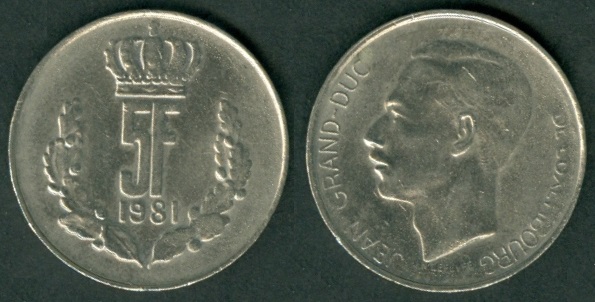 |
KM#56 5 Francs. Year:
1981. Weight:
6.05g. Metal:
Copper-Nickel. Edge:
Reeded. Diameter:
24.00 mm.
Thickness: 1.90
mm.
Alignment:
Coin. Mint:
N/A.
Obverse: Crown at the top. Value "5F" in
the center. Sprigs on both sides. Date written
below the Value.
Reverse:
Jean's portrait, facing left in the center. "JEAN GRAND-DUC"
on the left side clockwise and "DE LUXEMBOURG" at the right side
clockwise. "J.N. LEFEVRE"
designer's name written at the bottom. Mintage:
1,000,000.
Minted Years: 1971, 1976,
1979 and 1981.
Engraver: Julien
and Nina Lefèvre. |
|
| |
|
1982 |
| |
|
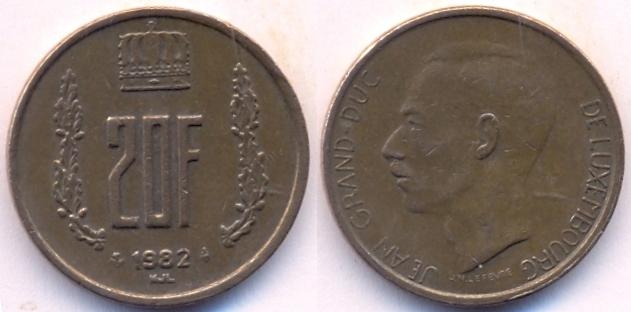 |
Same as above coin KM#58, but... Year:
1982. Weight:
8.52g. Mintage:
3,000,000. |
|
| |
|
1983 |
| |
|
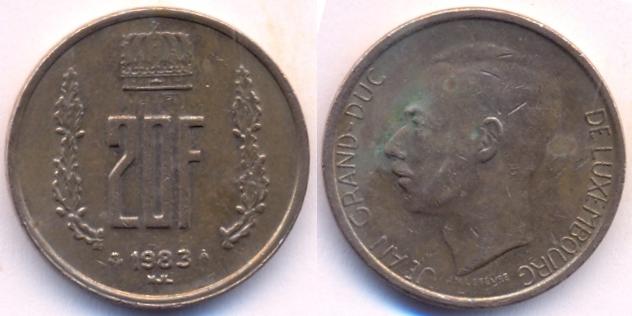 |
Same as above coin KM#58, but... Year:
1983. Weight:
8.52g. Mintage:
2,000,000. |
|
| |
|
1986 |
| |
|
 |
KM#60.1 5 Francs. Year:
1986. Weight:
5.54g. Metal:
Brass. Edge:
Plain. Diameter:
24.00 mm.
Thickness: 1.82
mm.
Alignment:
Coin. Mint:
N/A.
Obverse: Crown at the top. Date divided by the
Crown. Value "5F" in the center with "I.M.L." written
below it. Sprigs at the bottom. |
|
Reverse:
Jean's portrait, facing left in the center. "JEAN GRAND-DUC"
on the left side clockwise and "DE LUXEMBOURG" at the right side
clockwise. "J.N. LEFEVRE"
designer's name written at the bottom. Mintage:
7,000,000.
Minted Years: 1986-1988.
Engraver: Julien
and Nina Lefèvre. |
|
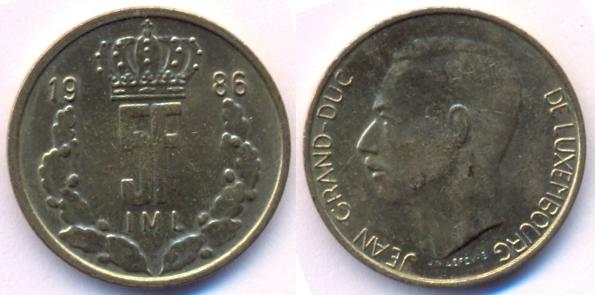 |
KM#60.2 5 Francs. Year:
1986. Weight:
5.49g. Metal:
Brass. Edge:
Plain. Diameter:
24.00 mm.
Thickness: 1.82
mm.
Alignment:
Coin. Mint:
N/A.
Obverse: Crown at the top. Date divided by the
Crown. Value "5F" in the center with "I.M.L." written
below it. Sprigs at the bottom. |
|
Reverse:
Jean's portrait, facing left in the center. "JEAN GRAND-DUC"
on the left side clockwise and "DE LUXEMBOURG" at the right side
clockwise. "J.N. LEFEVRE"
designer's name written at the bottom. Mintage:
N/A.
Minted Years: 1986-1987.
Engraver: Julien
and Nina Lefèvre.
Note: KM#60.2, 5 Francs dated 1986-1987
exists with extended border/rim which looks like larger crown. |
|
|
|
|
1987 |
|
|
|
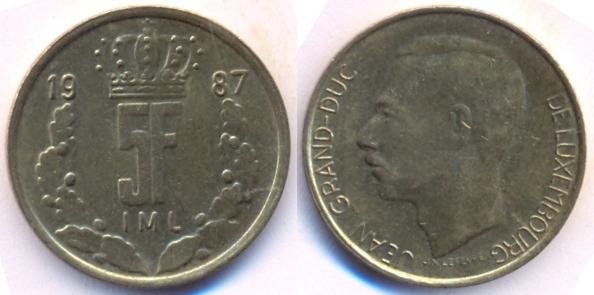 |
Same as above coin KM#60.2, but... Year:
1987. Weight:
5.53g. Mintage:
N/A. |
|
|
|
|
1988 |
|
|
|
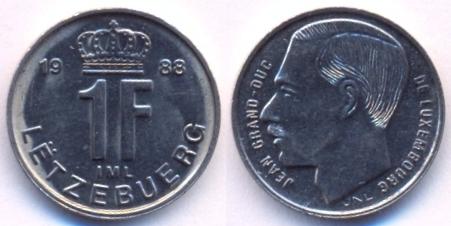 |
KM#63 1 Franc. Year:
1988. Weight:
2.76g. Metal:
Nickel-Steel. Edge:
Plain. Diameter:
18.00 mm.
Alignment:
Coin. Mint:
N/A.
Obverse: Crown at the top. Date divided by the
Crown. Value "1F" in the center with "I.M.L." written
below it. "LËTZEBUERG" written at the bottom. |
|
Reverse:
Jean's portrait, facing left in the center. "JEAN GRAND-DUC"
on the left side clockwise and "DE LUXEMBOURG" at the right side
clockwise. "J.N. L."
designer's initials written at the bottom. Mintage:
10,000,000.
Minted Years: 1988-1995
(1992-1995 in sets only). Engraver:
Julien and Nina Lefèvre. |
|
| |
|
1989 |
| |
|
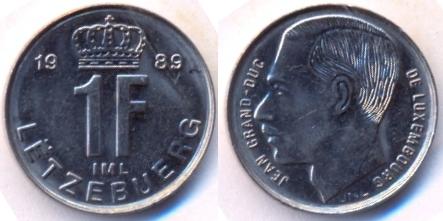 |
Same as above coin KM#63, but... Year:
1989. Weight:
2.75g. Mintage:
3,000,000. |
|
| |
|
1990 |
| |
|
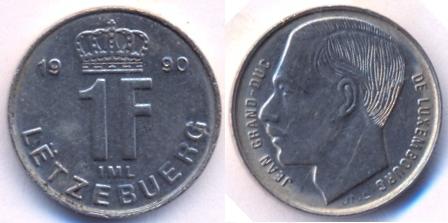 |
Same as above coin KM#63, but... Year:
1990. Weight:
2.82g. Mintage:
25,010,000. |
|
 |
KM#65 5 Francs. Year:
1990. Weight:
5.54g Metal:
Aluminium-bronze. Edge:
Plain. Diameter:
23.00 mm.
Alignment:
Coin. Mint:
N/A.
Obverse: Crown at the top. Date divided by the
Crown. Value "50F" in the center with "I.M.L." written
below it. "LËTZEBUERG" written at the bottom. |
|
Reverse:
Jean's portrait, facing left in the center. "JEAN GRAND-DUC"
written on the left side and "DE
LUXEMBOURG"
written on the right side; both clockwise. "J.N. L."
designer's initials written at the bottom. Mintage:
4,010,000.
Minted Years: 1989-1995
(1991-1995 in sets only). Engraver:
Julien and Nina Lefèvre. |
|
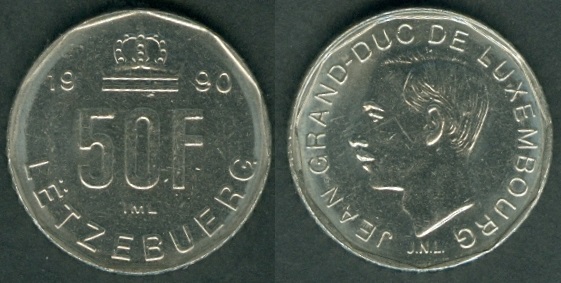 |
KM#66 50 Francs. Year:
1990. Weight:
7.02g Metal:
Nickel. Edge:
Reeded. Diameter:
22.00 mm.
Alignment:
Coin. Mint:
N/A.
Obverse: Crown at the top. Date divided by the
Crown. Value "50F" in the center with "I.M.L." written
below it. "LËTZEBUERG" written at the bottom. |
|
Reverse:
Jean's portrait, facing left in the center. "JEAN GRAND-DUC DE
LUXEMBOURG"
written around the portrait
clockwise. "J.N. L."
designer's initials written at the bottom. Mintage:
2,010,000.
Minted Years: 1989-1995
(1991-1995 in sets only). Engraver:
Julien and Nina Lefèvre. |
|
| |
|
1991 |
| |
|
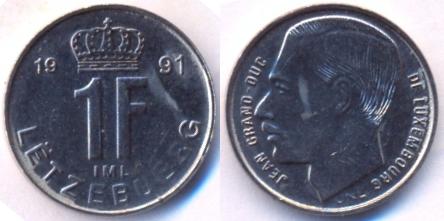 |
Same as above coin KM#63, but... Year:
1991. Weight:
2.77g. Mintage:
10,010,000. |
|
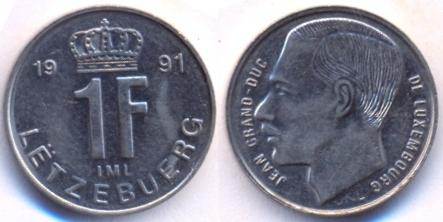 |
Same as above coin but slightly rotated from obverse
side as shown. Weight:
2.77g. |
|
| |
| |
|
Coins of Henri (2002-date) |
|
Monetary standard:
Euro = 100 euro cents. |
| The Belgian/Luxemburgese
franc ceased to exist in 01 January 1999, when it became fixed at 1 EUR =
40.3399 BEF/LUF, thus a franc was worth €0.024789. Old franc coins and notes
lost their legal tender status in 28 February 2002. It feature three
different designs, though they all contain the portrait or effigy of Grand
Duke Henri of Luxembourg. The designs, by Yvette Gastauer-Claire, also
contain the 12 stars of the EU flag, the year of imprint and the name of the
country in the Luxembourgish language: Lëtzebuerg. Luxembourg does not mint
its own coins. The Koninklijke Nederlandse Munt (Royal Dutch Mint), in
Utrecht, the Netherlands, produced Luxembourgish coins dated 2002–2004 and
again from 2009 onward. Rahapaja Oy (Mint of Finland), in Helsinki, Finland,
produced the coins dated 2005–2006. Monnaie de Paris (Mint of Paris), in
Pessac, France, produced coins dated 2007-2008. Luxembourg.
Designer:
Yvette Gastauer-Claire (obverse by Luxembourger artist) and Luc Luycx (reverse) |
Luxembourg is the only member of the Eurozone to have all of
their coins produced at three different foreign mints. This piece was
engraved by severals contries and by severals engravers according to the
following periods:
- 2002
Utrecht, Netherlands : caduceus - Mark : bow and
star - W. J. van Schauwenburg (interim).
- 2003 - 2004
Utrecht, Netherlands : caduceus - Mark : Sails -
Maarten Brouwer (holder).
- 2005 - 2006
Rahapaja Oy, Finland : "S" and logo of Vanda
mint.
- 2007 - 2008
Monnaie de Paris, France : horn of plenty and
"F" in star - Mark : hunting horn, , a wave and a fish - Hubert
Lariviere.
- 2009 - 2015
Utrecht, Netherlands : caduceus - Mark : Sails -
Maarten Brouwer (holder).
- 2016 - 2017
Utrecht, Netherlands : caduceus - Mark : Sails
and star - Kees Bruinsma (interim).
- 2018 Sint Servaasbrug, Netherlands :
Mark : Pesac.
|
|
|
|
2002 |
|
|
|
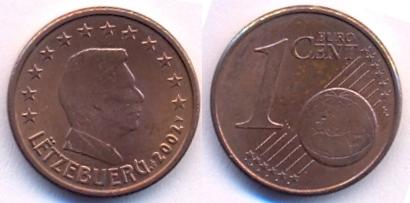 |
KM#75
1 euro cents.
Year: 2002.
Weight: 2.31g.
Metal: Copper
plated steel. Diameter:
16.25 mm.
Thickness:
1.67 mm. Edge:
Plain.
Alignment: Medal.
Mint: Utrecht.
Obverse:
Henri's portrait, facing right in the center. 12 stars above him. "LËTZEBUERG"
at the bottom with Date on the right side. |
|
Reverse:
Map of Europe with the denomination
shown in Latin characters.
Mintage:
34,557,500 + 72,002 in sets + 1,500 in
Proofs.
Minted Years:
2002-2018. |
|
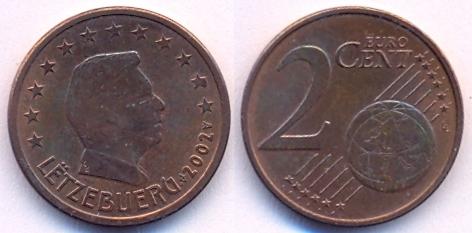 |
KM#76
2 euro cents.
Year: 2002.
Weight: 3.10g.
Metal: Copper
plated steel. Diameter:
18.75 mm.
Thickness:
1.67 mm. Edge:
Smooth with a groove running
circumferentially around.
Alignment: Medal.
Mint: Utrecht.
Obverse:
Henri's portrait, facing right in the center. 12 stars above him. "LËTZEBUERG"
at the bottom with Date on the right side. |
|
Reverse:
Map of Europe with the denomination
shown in Latin characters.
Mintage:
35,957,500 + 72,002 in sets + 1,500 in
Proofs.
Minted Years:
2002-2018. |
|
 |
KM#77
5 euro cents.
Year: 2002.
Weight: 3.90g.
Metal: Copper
plated steel. Diameter:
21.25 mm.
Thickness:
1.67 mm. Edge:
Plain.
Alignment: Medal.
Mint: Utrecht.
Obverse:
Henri's portrait, facing right in the center. 12 stars above him. "LËTZEBUERG"
at the bottom with Date on the right side. |
|
Reverse:
Map of Europe with the denomination
shown in Latin characters.
Mintage:
28,117,500 + 72,002 in sets + 1,500 in
Proofs.
Minted Years:
2002-2018. |
|
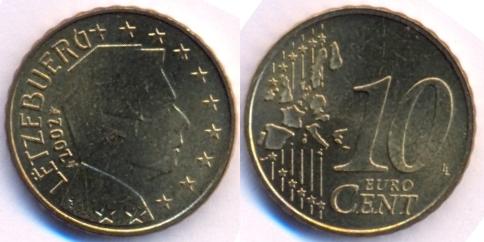 |
KM#78
10 euro cents.
Year: 2002.
Weight: 4.09g.
Metal:
Nordic gold. Diameter:
19.75 mm.
Thickness:
1.93 mm. Edge:
Reeded.
Alignment: Medal.
Mint: Utrecht.
Obverse:
Henri's portrait, facing right in the center. 12 stars above him. "LËTZEBUERG"
at the bottom with Date on the right side. |
|
Reverse:
Map of Europe with the denomination
shown in Latin characters.
Mintage:
25,117,500
+ 72,002 in sets + 1,500 in Proofs.
Minted Years:
2002-2006. Nordic Gold:
89% copper, 5% aluminium, 5% zinc, and 1% tin. |
|
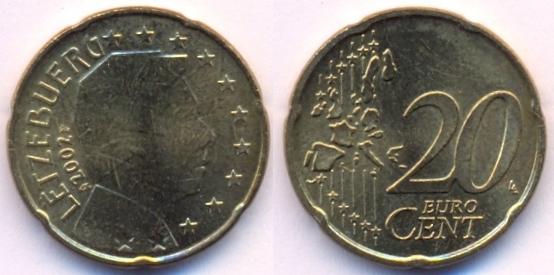 |
KM#79
20 euro cents.
Year: 2002.
Weight: 5.73g.
Metal:
Nordic gold. Diameter:
22.25 mm.
Thickness:
2.14 mm. Edge:
Notched (Plain with seven indentations from the
coin's "Spanish flower" shape).
Alignment: Medal.
Mint: Utrecht.
Obverse:
Henri's portrait, facing right in the center. 12 stars above him. "LËTZEBUERG"
at the bottom with Date on the right side. |
|
Reverse:
Map of Europe with the denomination
shown in Latin characters.
Mintage:
25,717,500 + 72,002 in sets + 1,500 in
Proofs.
Minted Years:
2002-2006. |
|
 |
KM#80
50 euro cents.
Year: 2002.
Weight: 7.89g.
Metal:
Nordic gold. Diameter:
24.25 mm.
Thickness:
2.38 mm. Edge:
Reeded.
Alignment: Medal.
Mint: Utrecht.
Obverse:
Henri's portrait, facing right in the center. 12 stars above him. "LËTZEBUERG"
at the bottom with Date on the right side. |
|
Reverse:
Map of Europe with the denomination
shown in Latin characters.
Mintage:
21,957,500 + 72,002 in sets + 1,500 in
Proofs.
Minted Years:
2002-2006.
|
|
 |
KM#81
1 Euro.
Year: 2002.
Weight: 7.47g.
Metal:
Bi-Metallic; Copper-nickel center in
Brass ring. Diameter:
23.25 mm.
Thickness:
2.33 mm. Edge:
Alternating segments, three smooth,
three finely ribbed.
Alignment: Medal.
Mint: Utrecht.
Obverse:
Henri's portrait, facing right in the center
right side.
Date and
"LËTZEBUERG" written vertically in the
center on left side.
12 stars around him in outer circle. |
|
Reverse:
Map of Europe with the denomination
shown in Latin characters.
Mintage:
21,318,525
+ 72,002 in sets + 1,500 in Proofs.
Minted Years:
2002-2006. |
|
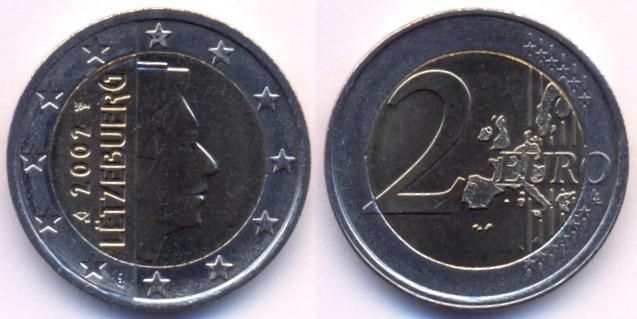 |
KM#82
2 Euros.
Year: 2002.
Weight: 8.56g.
Metal:
Bi-Metallic; Brass center in
Copper-nickel ring. Diameter:
25.75 mm.
Thickness:
2.20 mm.
Edge:
Reeded and lettering;
The sequence "2 * *" repeated six times
alternately upright and inverted.
Alignment: Medal.
Mint: Utrecht.
Obverse:
Henri's portrait, facing right in the center
right side.
Date and "LËTZEBUERG" written
vertically in the center on left side.
12 stars around him in outer circle. |
|
Reverse:
Map of Europe with the denomination
shown in Latin characters.
Mintage:
18,517,500
+ 72,002 in sets + 1,500 in
Proofs..
Minted Years:
2002-2006. |
|
|
|
|
2004 |
|
|
|
 |
KM#75
1 euro cent.
Year: 2004.
Weight: 2.30g.
Mint: Utrecht.
Mintage:
21,061,000 + 68,555 in sets + 1,500 in
Proofs.
Note:
Details above, under 2002 issue. |
|
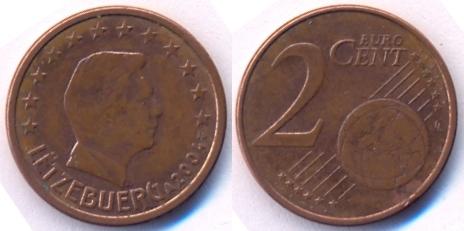 |
KM#76
2 euro cents.
Year: 2004.
Weight: 3.04g.
Mint: Utrecht.
Mintage:
20,061,000
+ 68,555 in sets + 1,500 in Proofs.
Note:
Details above, under 2002 issue. |
|
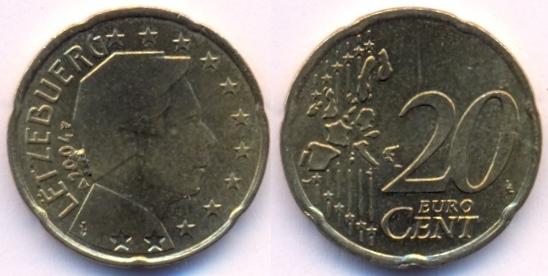 |
KM#79
20 euro cents.
Year: 2004.
Weight: 5.71g.
Mint: Utrecht.
Mintage:
14,001,000
+ 68,555 in sets + 1,500 in Proofs.
Note:
Details above, under 2002 issue. |
|
|
|
|
2005 |
|
|
|
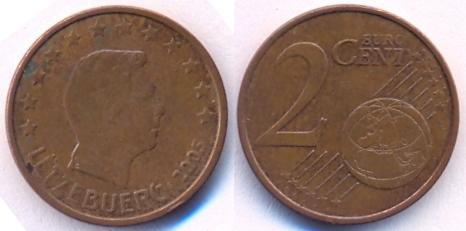 |
KM#76
2 euro cents.
Year: 2005.
Weight: 3.08g.
Mint:
Rahapaja Oy,
Helsinki,
Finland.
Mintage:
13,040,000 + 47,000 in sets + 1,500 in
Proofs..
Note:
Details above, under 2002 issue. |
|
|
|
|
2006 |
|
|
|
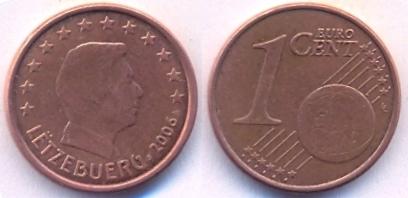 |
KM#75
1 euro cent.
Year: 2006.
Weight: 2.31g.
Mint:
Rahapaja Oy,
Helsinki,
Finland.
Mintage:
4,000,000 + 30,000 in sets + 2,000 in
Proofs.
Note:
Details above, under 2002 issue. |
|
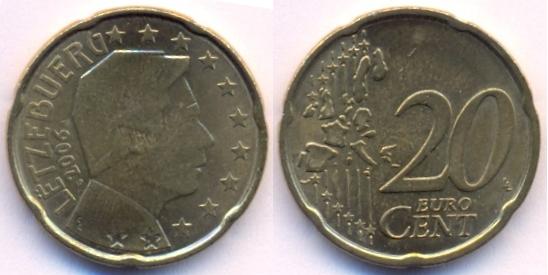 |
KM#79
20 euro cents.
Year: 2006.
Weight: 5.75g.
Mint:
Rahapaja Oy, Helsinki, Finland.
Mintage:
7,000,000 + 32,500 in sets +
2,000 in Proofs..
Note:
Details above, under 2002 issue. |
|
|
|
|
2009 |
|
|
|
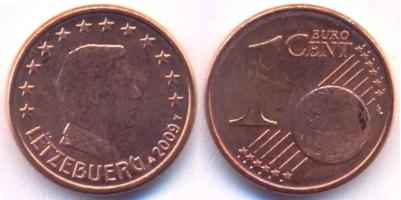 |
KM#75
Year: 2009.
Weight: 2.30g.
Mint: Utrecht.
Mintage:
4,022,500 + 26,000 in sets + 2,000 in
Proofs.
Note:
Details above, under 2002 issue. |
|
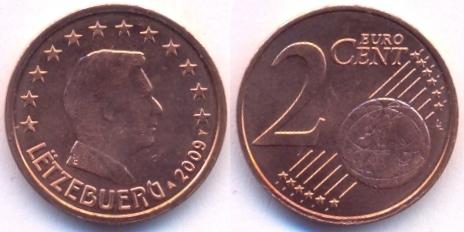 |
KM#76
Year: 2009.
Weight: 3.03g.
Mint: Utrecht.
Mintage:
3,022,500 + 26,000 in sets + 2,000 in
Proofs.
Note:
Details above, under 2002 issue. |
|
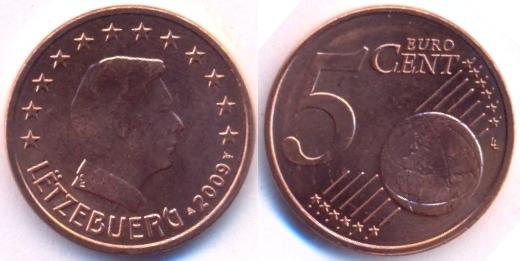 |
KM#77
Year: 2009.
Weight: 3.99g.
Mint: Utrecht.
Mintage:
6,022,500
+ 26,000 in sets + 2,000 in Proofs.
Note:
Details above, under 2002 issue. |
|
 |
KM#89
10 euro cents.
Year: 2009.
Weight: 4.08g.
Metal:
Nordic gold. Diameter:
19.75 mm.
Thickness:
1.93 mm. Edge:
Reeded.
Alignment: Medal.
Mint: Utrecht.
Obverse:
Henri's portrait, facing right in the center. 12 stars above him. "LËTZEBUERG"
at the bottom with Date on the right side. |
|
Reverse:
Map of Europe with the denomination
shown in Latin characters.
Mintage:
4,022,500 + 26,000 in sets + 2,000 in
Proofs.
Minted Years:
2007-2018. |
|
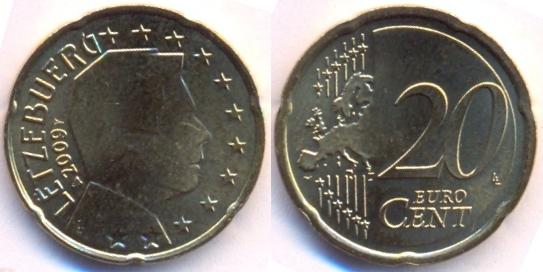 |
KM#90
20 euro cents.
Year: 2009.
Weight: 5.74g.
Metal:
Nordic gold. Diameter:
22.25 mm.
Thickness:
2.14 mm. Edge:
Notched (Plain with seven indentations from the
coin's "Spanish flower" shape).
Alignment: Medal.
Mint: Utrecht.
Obverse:
Henri's portrait, facing right in the center. 12 stars above him. "LËTZEBUERG"
at the bottom with Date on the right side. |
|
Reverse:
Map of Europe with the denomination
shown in Latin characters.
Mintage:
5,022,500 + 26,000 in sets + 2,000 in
Proofs.
Minted Years:
2007-2018. |
|
 |
KM#91
50 euro cents.
Year: 2009.
Weight: 7.74g.
Metal:
Nordic gold. Diameter:
24.25 mm.
Thickness:
2.38 mm. Edge:
Reeded.
Alignment: Medal.
Mint: Utrecht.
Obverse:
Henri's portrait, facing right in the center. 12 stars above him. "LËTZEBUERG"
at the bottom with Date on the right side. |
|
Reverse:
Map of Europe with the denomination
shown in Latin characters.
Mintage:
2,022,500 + 26,000 in sets + 2,000 in
Proofs.
Minted Years:
2007-2018. |
|
 |
KM#92
1 Euro.
Year: 2009.
Weight: 7.46g.
Metal:
Bi-Metallic; Copper-nickel center in
Brass ring. Diameter:
23.25 mm.
Thickness:
2.33 mm. Edge:
Alternating segments, three smooth,
three finely ribbed.
Alignment: Medal.
Mint: Utrecht.
Obverse:
Henri's portrait, facing right in the center
right side.
Date and
"LËTZEBUERG" written vertically in the
center on left side.
12 stars around him in outer circle. |
|
Reverse:
Map of Europe with the denomination
shown in Latin characters.
Mintage:
262,500 + 26,000 in sets + 2,000 in
Proofs.
Minted Years:
2007-2018. |
|
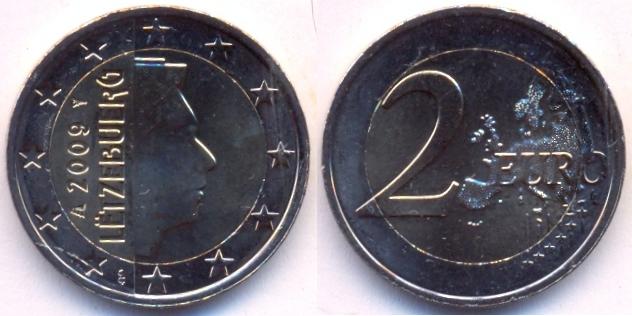 |
KM#93
2 Euros.
Year: 2009.
Weight: 8.44g.
Metal:
Bi-Metallic; Brass center in
Copper-nickel ring. Diameter:
25.75 mm.
Thickness:
2.20 mm.
Edge:
Reeded and lettering;
The sequence "2 * *" repeated six times
alternately upright and inverted.
Alignment: Medal.
Mint: Utrecht.
Obverse:
Henri's portrait, facing right in the center
right side.
Date and "LËTZEBUERG" written
vertically in the center on left side.
12 stars around him in outer circle. |
|
Reverse:
Map of Europe with the denomination
shown in Latin characters.
Mintage:
250,500 + 13,500 in sets + 2,000 in
Proofs.
Minted Years:
2007-2018. |
|
|
|
|
2018 |
|
|
|
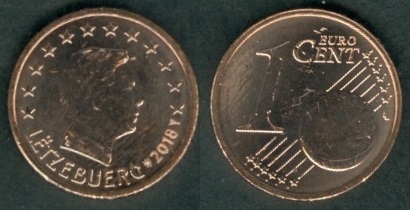 |
KM#75
1 euro cent.
Year: 2018.
Weight: 2.31g.
Mint:
Sint Servaasbrug, Netherlands.
Mintage:
5,050,000 + N.A in sets + N.A in Proofs.
Note:
Details above, under 2002 issue. |
|
 |
KM#76
2 euro cents.
Year: 2018.
Weight: 3.05g.
Mint:
Sint Servaasbrug, Netherlands.
Mintage:
5,050,000 + N.A in sets + N.A in Proofs.
Note:
Details above, under 2002 issue. |
|
 |
KM#77
5 euro cents.
Year: 2018.
Weight: 3.91g.
Mint:
Sint Servaasbrug, Netherlands.
Mintage:
3,050,000 + N.A in sets + N.A in Proofs.
Note:
Details above, under 2002 issue. |
|
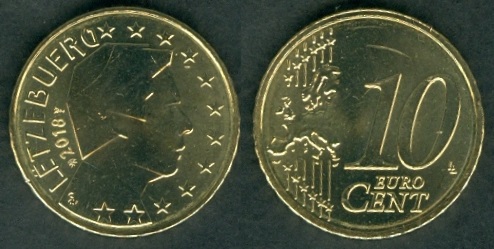 |
KM#89
10 euro cents.
Year: 2018.
Weight: 4.14g.
Mint:
Sint Servaasbrug, Netherlands.
Mintage:
2,050,000 + N.A in sets + N.A in Proofs.
Note:
Details above, under 2009 issue. |
|
 |
KM#90
20 euro cents.
Year: 2018.
Weight: 5.79g.
Mint:
Sint Servaasbrug, Netherlands.
Mintage:
50,000 + N.A in sets + N.A in Proofs.
Note:
Details above, under 2009 issue.
|
|
 |
KM#91
50 euro cents.
Year: 2018.
Weight: 7.75g.
Mint:
Sint Servaasbrug, Netherlands.
Mintage:
50,000 + N.A in sets + N.A in Proofs.
Note:
Details above, under 2009 issue. |
|
 |
KM#92
1 Euro.
Year: 2018.
Weight: 7.52g.
Mint:
Sint Servaasbrug, Netherlands.
Mintage:
50,000 + N.A in sets + N.A in Proofs.
Note:
Details above, under 2009 issue. |
|
 |
KM#93
2 Euros.
Year: 2018.
Weight: 8.44g.
Mint:
Sint Servaasbrug, Netherlands.
Mintage:
50,000 + N.A in sets + N.A in Proofs.
Note:
Details above, under 2009 issue. |
|
|
|
|
2 Euros Commemorative coins 2004 - date |
|
|
|
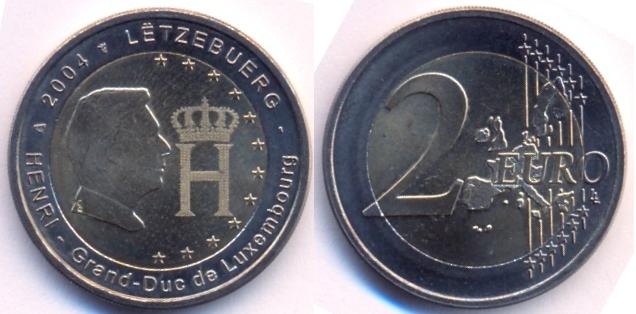 |
KM#85
2 Euros.
Year: 2004.
Weight: 8.56g.
Metal:
Bi-Metallic; Brass center in
Copper-nickel ring. Diameter:
25.75 mm.
Thickness:
2.20 mm.
Edge:
Reeded and lettering;
The sequence "2 * *" repeated six times
alternately upright and inverted..
Alignment: Medal.
Mint: Utrecht. |
|
Obverse:
Henri's portrait, facing right in the center
left side and his monogram (the letter H topped with a
crown). The twelve stars of the European Union are also on the right
side of the inner part, surrounding the monogram in a semicircular
form. Date at
the top left side and "LËTZEBUERG"
written at top right side. "HENRI - Grand-Duc de Luxembourg" written
at the bottom.
Reverse:
Map of Europe with the denomination
shown in Latin characters.
Mintage:
2,500,000 + 50,000 in sets + 4,000 in
Proofs.
Minted Years: One
year type. Issue Date:
23 June 2004. |
|
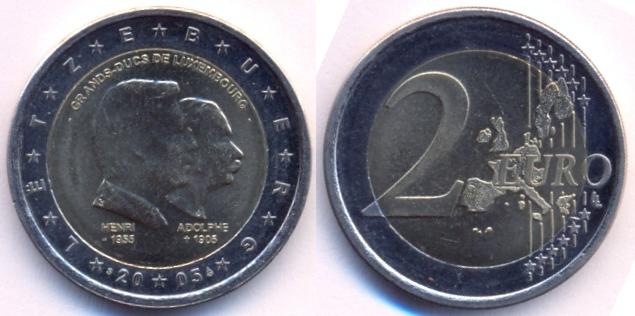 |
KM#87
2 Euros.
Year: 2005.
Weight: 8.38g.
Metal:
Bi-Metallic; Brass center in
Copper-nickel ring. Diameter:
25.75 mm.
Thickness:
2.20 mm.
Edge:
Reeded and lettering;
The sequence "2 * *" repeated six times
alternately upright and inverted..
Alignment: Medal.
Mint:
Rahapaja Oy, Helsinki, Finland.
|
|
Obverse:
Henri (on left) and Adolphe (on right) portraits in the center, both
facing right.
"GRANDS-DUCS DE LUXEMBOURG" written
above them.
"HENRI" with his birth year "*1955" written below his portrait. "ADOLPHE"
with his death year "†1905" written below his portrait. "*L*
Ë*T*Z*E*B*U*E*R*G*" written clockwise in outer circle.
"20*05" with mint marks, letter S on left side at the bottom.
Reverse:
Map of Europe with the denomination
shown in Latin characters.
Mintage:
2,800,000 + 50,500 in sets + 4,000 in
Proofs.
Minted Years: One
year type. Issue Date:
15 Jan 2005. Subject:
50th Birthday of Grand Duke Henri, 5th Anniversary of his Accession
to the Throne and 100th Anniversary of the Death of Grand Duke
Adolphe. |
|
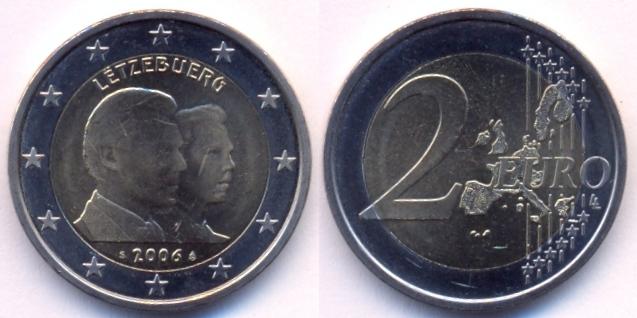 |
KM#88
2 Euros.
Year: 2006.
Weight: 8.37g.
Metal:
Bi-Metallic; Brass center in
Copper-nickel ring. Diameter:
25.75 mm.
Thickness:
2.20 mm.
Edge:
Reeded and lettering;
The sequence "2 * *" repeated six times
alternately upright and inverted..
Alignment: Medal.
Mint:
Rahapaja Oy, Helsinki, Finland. |
|
Obverse:
The coin depicts the effigy of Grand Duke Henri on the right side of
the inner part, superimposed on the effigy of Hereditary Grand Duke
Guillaume on the left side; both are looking to the right. The year
mark appears below the effigies, flanked by the letter S and the
mint mark. The inscription LËTZEBUERG appears above the effigies
along the upper edge of the inner part of the coin. The twelve stars
of the European Union surround the design on the outer ring of the
coin.
Reverse:
Map of Europe with the denomination
shown in Latin characters.
Mintage:
1,100,000 + 45,500 in sets + 4,500 in
Proofs.
Minted Years: One
year type. Issue Date:
11 Jan 2006. Subject:
25th Birthday of Hereditary Grand Duke Guillaume. |
|
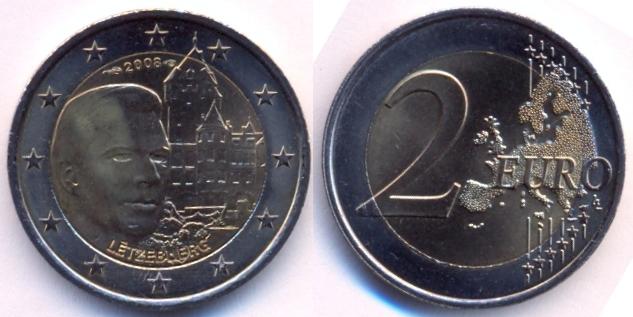 |
KM#96
2 Euros.
Year: 2008.
Weight: 8.38g.
Metal:
Bi-Metallic; Brass center in
Copper-nickel ring. Diameter:
25.75 mm.
Thickness:
2.20 mm.
Edge:
Reeded and lettering;
The sequence "2 * *" repeated six times
alternately upright and inverted..
Alignment: Medal.
Mint:
Paris. |
|
Obverse:
The inner part of the coin shows, in the foreground on the left side
the effigy of Grand Duke Henri looking to the right and in the
background on the right side the picture of Berg Castle. The year
mark is flanked by the mint mark and the mint master mark of the
engraving workshop at the top of the coin. The name of the issuing
country LËTZEBUERG appears at the bottom of the design. The twelve
stars of the European Union surround the design on the outer ring of
the coin.
Reverse:
Map of Europe with the denomination
shown in Latin characters.
Mintage:
1,300,000 + 37,500 in sets + 5,000 in
Proofs.
Minted Years: One
year type. Issue Date:
02 Feb 2008. |
|
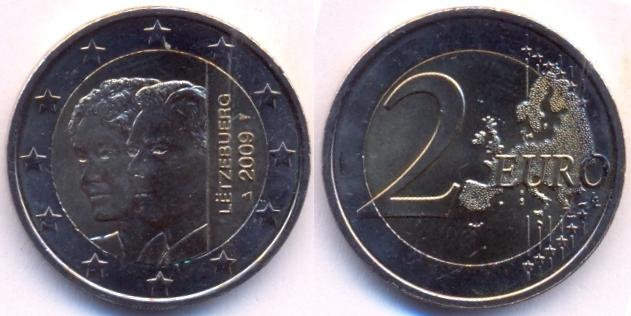 |
KM#106
2 Euros.
Year: 2009.
Weight: 8.50g.
Metal:
Bi-Metallic; Brass center in
Copper-nickel ring. Diameter:
25.75 mm.
Thickness:
2.20 mm.
Edge:
Reeded and lettering;
The sequence "2 * *" repeated six times
alternately upright and inverted..
Alignment: Medal.
Mint: Utrecht. |
|
Obverse:
The coin shows the effigy of Grand Duke Henri on the left hand side
of its inner part, superimposed on the effigy of the Grand Duchess
Charlotte, both looking to the left. The vertically aligned text
LËTZEBUERG and the year mark, flanked by the mint master's mark and
the mint mark, appear on the right hand side of the inner part of
the coin. The twelve stars of the European Union surround the design
on the outer ring of the coin.
Reverse:
Map of Europe with the denomination
shown in Latin characters.
Mintage:
1,400,000 + 32,500 in sets + 2,000 in
Proofs.
Minted Years: One
year type. Issue Date:
01 Jan 2009. Subject:
90th Anniversary of Grand Duchess Charlotte's
Accession to the Throne. |
|
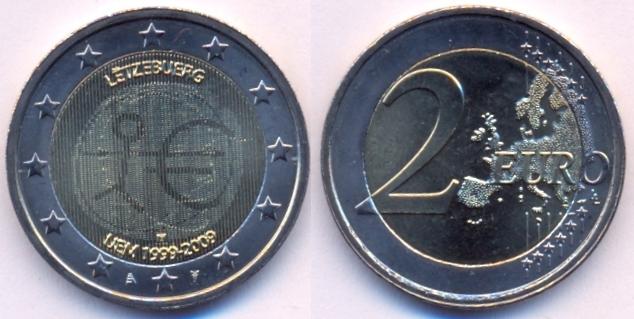 |
KM#107
2 Euros.
Year: 2009.
Weight: 8.50g.
Metal:
Bi-Metallic; Brass center in
Copper-nickel ring. Diameter:
25.75 mm.
Thickness:
2.20 mm.
Edge:
Reeded and lettering;
The sequence "2 * *" repeated six times
alternately upright and inverted..
Alignment: Medal.
Mint: Utrecht. |
|
Obverse: The centre of the coin shows a
stylised human figure whose left arm is prolonged by the euro
symbol. The initials ΓΣ of the sculptor appear below the euro
symbol. The name of the issuing country in the national language "LËTZEBUERG"
appears at the top, while the indication 1999–2009 and the acronym
EMU translated into the national language "UEM" appear at the
bottom. The twelve stars of the European Union surround the design
on the outer ring of the coin. Due to special laws requiring that
every coin bear the incumbent Grand Duke's portrait, the
Luxembourgish edition of the common €2 commemorative coin differs
slightly from the others in addition to the translated inscriptions,
since two latent image of the Grand Duke's portrait were added (as
required by national law). The method used (multi-view-minting) was
even more sophisticated than the one used in 2007, as portraits of
the Grand Duke from the left and the right could be seen, depending
on which way one tilted the coin.
Reverse:
Map of Europe with the denomination
shown in Latin characters.
Mintage:
1,400,000 + 20,000 in sets + 2,000 in
Proofs.
Minted Years: One
year type. Issue Date:
01 Jan 2009. Subject:
Ten years of Economic and Monetary Union (EMU)
and the birth of the Euro.
Note:
The final design of the coin was chosen
by electronic voting from 31 January 2008 to 22 February 2008, with
the result announced on 25 February 2008. The designs were
pre-selected by the national mint directors of the eurozone. The
winner was George Stamatopoulos, a sculptor from the Bank of Greece
Mint. |
|
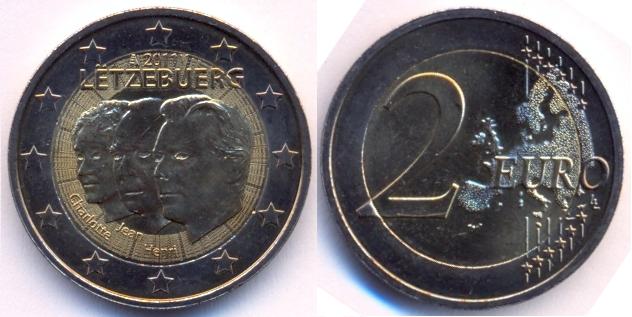 |
KM#116
2 Euros.
Year: 2011.
Weight: 8.50g.
Metal:
Bi-Metallic; Brass center in
Copper-nickel ring. Diameter:
25.75 mm.
Thickness:
2.20 mm.
Edge:
Reeded and lettering;
The sequence "2 * *" repeated six times
alternately upright and inverted..
Alignment: Medal.
Mint: Utrecht. |
|
Obverse:
The inner part of the coin depicts Henri, Grand Duke of Luxembourg
on the right-hand side looking to the left, and superimposed on the
effigies of Jean, Grand Duke of Luxembourg and Charlotte, Grand
Duchess of Luxembourg. The text LËTZEBUERG is written above the
three effigies. The year mark 2011, surrounded by the mint mark and
the mintmaster mark, appears at the top. The name of the person
depicted is written below the respective effigy. The twelve stars of
the European Union surround the design on the outer ring of the
coin.
Reverse:
Map of Europe with the denomination
shown in Latin characters.
Mintage:
700,000
+ 25,000 in sets + 1,500 in
Proofs.
Minted Years: One
year type. Issue Date:
03 Feb 2011. Subject:
50th Anniversary of the Appointment of Jean,
Grand Duke of Luxembourg by his mother Charlotte, Grand Duchess of
Luxembourg as lieutenant-représentant. |
|
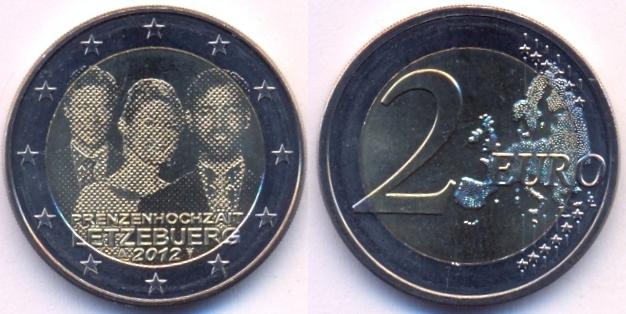 |
KM#120 2 Euros.
Year: 2012.
Weight: 8.50g.
Metal:
Bi-Metallic; Brass center in
Copper-nickel ring. Diameter:
25.75 mm.
Thickness:
2.20 mm.
Edge:
Reeded and lettering;
The sequence "2 * *" repeated six times
alternately upright and inverted..
Alignment: Medal.
Mint: Utrecht. |
|
Obverse:
Hologram of Prince Guillaume on the right, Princess Stéphanie in the
center and Prince Henri on the left. "PRËNZENHOCHZÄIT
LËTZEBUERG 2012" written below them.
The twelve stars of
the European Union surround the design on the outer ring of the
coin.
Reverse:
Map of Europe with the denomination
shown in Latin characters.
Mintage:
500,000
+ 10,000 in sets + 2,000 in Proofs.
Minted Years: One
year type. Issue Date:
Jan 2013. Subject:
Royal Wedding of Guillaume, Hereditary Grand
Duke of Luxembourg to Royal Wedding of Guillaume, Hereditary Grand
Duke of Luxembourg to Belgian
Countess
Stéphanie de Lannoy.
Note: The
wedding took place over a two-day period on October 19 and October
20, 2012. A civil ceremony was held on October 19 followed by a
Roman Catholic wedding ceremony at Notre-Dame Cathedral in
Luxembourg City the next day. |
|
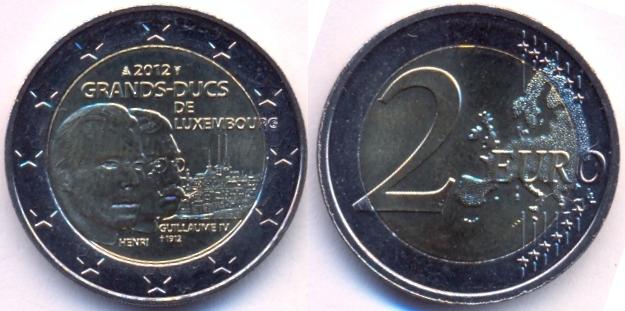 |
KM#121 2 Euros.
Year: 2012.
Weight: 8.50g.
Metal:
Bi-Metallic; Brass center in
Copper-nickel ring. Diameter:
25.75 mm.
Thickness:
2.20 mm.
Edge:
Reeded and lettering;
The sequence "2 * *" repeated six times
alternately upright and inverted..
Alignment: Medal.
Mint: Utrecht. |
|
Obverse: The inner part of the coin
depicts Grand Duke Henri (looking to the right) on the left side,
superimposed on Grand Duke William IV, looking to the right. The
inscription GRANDS-DUCS DE LUXEMBOURG and the year mark
appear above the effigies, flanked by the mintmark and the initials
of the mint master. In front of the effigies, the outline of the
city of Luxembourg appears as a background. The names HENRI
and GUILLAUME IV and the text † 1912 are written below
the respective effigies.
The twelve stars of
the European Union surround the design on the outer ring of the
coin.
Reverse:
Map of Europe with the denomination
shown in Latin characters.
Mintage:
700,000 + 10,000
in sets + 2,000 in Proofs.
Minted Years: One
year type. Issue Date:
09 Feb 2012. Subject:
100th Death Anniversary
of William IV. |
|
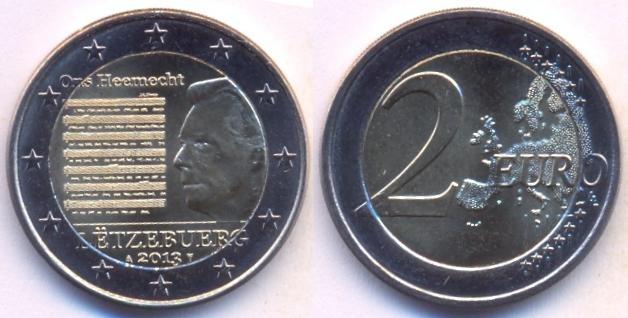 |
KM#125 2 Euros.
Year: 2013.
Weight: 8.48g.
Metal:
Bi-Metallic; Brass center in
Copper-nickel ring. Diameter:
25.75 mm.
Thickness:
2.20 mm.
Edge:
Reeded and lettering;
The sequence "2 * *" repeated six times
alternately upright and inverted..
Alignment: Medal.
Mint: Utrecht. |
|
Obverse: The coin depicts on the right
hand of its inner part the effigy of His Royal Highness, the Grand
Duke Henri, looking to the left, and on the left hand of its inner
part the musical notation as well as the text of the national
anthem. The text ‘Ons Heemecht’ appears at the top of the inner part
and the name of the issuing country ‘LËTZEBUERG’ as well as the
year-date ‘2013’, flanked by the mint mark and the initials of the
mint master, appear at the bottom of the inner part of the coin. The
coin’s outer ring depicts the 12 stars of the European flag.
Reverse:
Map of Europe with the denomination
shown in Latin characters.
Mintage:
719,500 + 10,000
in sets + 2,000 in Proofs.
Minted Years: One
year type. Issue Date:
16 Oct 2013. Subject:
National Anthem.
Note:
"Ons Heemecht" is the national anthem
of Luxembourg. The title in Luxembourgish translates as Our
Homeland. Michel Lentz wrote the words in 1859, and they were set to
music by Jean Antoine Zinnen in 1864. The song was first performed
in public in Ettelbruck, a town at the confluence of the Alzette and
Sauer rivers (both of which are mentioned in the song), on 05 June
1864. |
|
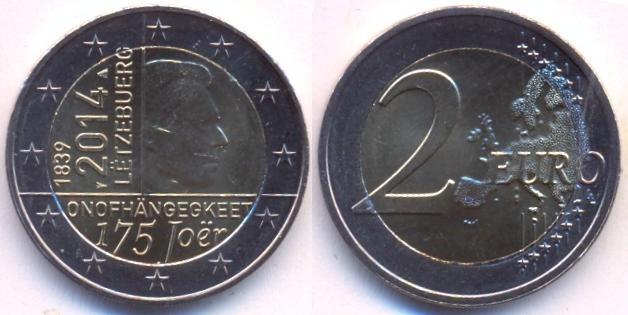 |
KM#129 / Schön#121 2 Euros.
Year: 2014.
Weight: 8.48g.
Metal:
Bi-Metallic; Brass center in
Copper-nickel ring. Diameter:
25.75 mm.
Thickness:
2.20 mm.
Edge:
Reeded and lettering;
The sequence "2 * *" repeated six times
alternately upright and inverted..
Alignment: Medal.
Mint: Utrecht. |
|
Obverse:
The coin depicts on the right hand side of its inner part the effigy
of His Royal Highness, the Grand-Duke Henri, looking to the right,
and on the left hand side of its inner part, vertically positioned,
the years ‘1839’ and ‘2014’ and the name of the issuing country ‘LËTZEBUERG’.
The inscriptions ‘ONOFHÄNGEGKEET’ and ‘175 Joër’ appear at the
bottom of the inner part of the coin. The coin’s outer ring depicts
the 12 stars of the European flag.
Reverse:
Map of Europe with the denomination
shown in Latin characters.
Mintage:
519,500 + 10,000
in sets + 2,000 in Proofs.
Minted Years: One
year type. Issue Date:
06 Jan 2014. Subject:
175th Anniversary of the Foundation of
Luxembourg's Independence.
Note:
After the defeat of Napoleon in 1815,
Luxembourg was disputed between Prussia and the Netherlands. The
Congress of Vienna formed Luxembourg as a Grand Duchy within the
German Confederation in personal union with the Netherlands, being
at the same time a part of the Netherlands and ruled as one of its
provinces, with a Confederate fortress manned by Prussian troops.
This situation was revised by the 1839 First Treaty of London, from
which date Luxembourg's full independence is reckoned. |
|
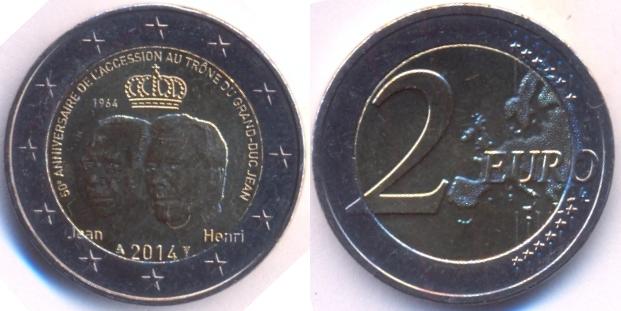 |
Schön#122 2 Euros.
Year: 2014.
Weight: 8.52g.
Metal:
Bi-Metallic; Brass center in
Copper-nickel ring. Diameter:
25.75 mm.
Thickness:
2.20 mm.
Edge:
Reeded and lettering;
The sequence "2 * *" repeated six times
alternately upright and inverted..
Alignment: Medal.
Mint: Utrecht. |
|
Obverse:
The coin’s inner part depicts the effigies of Their Royal
Highnesses, the Grand-Duke Henri and the Grand-Duke Jean, both
looking to the left. It is surmounted by the year ‘1964’ above the
effigy of the Grand-Duke Jean and by a crown. At the bottom, the
names ‘Jean’ and ‘Henri’ appear below the respective effigy as well
as the year ‘2014’. The inscription ‘50e ANNIVERSAIRE DE L’ACCESSION
AU TRÔNE DU GRAND-DUC JEAN’ encloses in circular form the upper
inner part of the coin. The coin's outer ring depicts the 12 stars
of the European flag.
Reverse:
Map of Europe with the denomination
shown in Latin characters.
Mintage:
510,000 + 10,000
in sets + 2,000 in Proofs.
Minted Years: One
year type. Issue Date:
06 Nov 2014. Subject:
50th Anniversary (Golden Jubilee) of Grand
Duke Jean Accession to the Throne. |
|
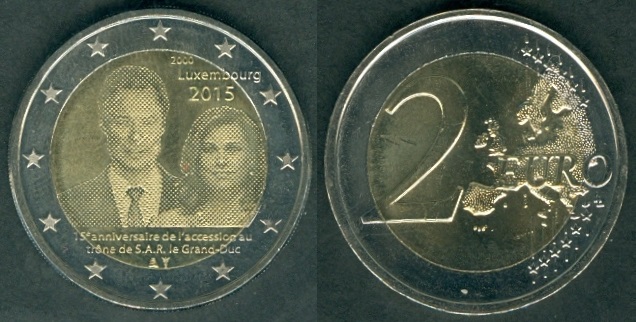 |
Schön#127 2 Euros.
Year: 2015.
Weight: 8.52g.
Metal:
Bi-Metallic; Brass center in
Copper-nickel ring. Diameter:
25.75 mm.
Thickness:
2.20 mm.
Edge:
Reeded and lettering;
The sequence "2 * *" repeated six times
alternately upright and inverted..
Alignment: Medal.
Mint: Utrecht. |
|
Obverse:
The coin depicts Hologram of their Royal Highnesses Grand Duke Henri and the
Grand Duchess María Teresa Mestre y Batista. The year of accession
‘2000’, the issuing country ‘Luxembourg’ and the year mark ‘2015’
appear above them. Below them appears the inscription ‘15e
anniversaire de l’accession au trône de S.A.R. le Grand-Duc’ (15th
anniversary of the accession to the throne of H.R.H. the Grand
Duke). The coin's outer ring depicts the 12 stars of the European
flag.
Reverse:
Map of Europe with the denomination
shown in Latin characters.
Mintage:
500,000
+ 7,500 in coin cards + 1,500 in Proofs.
Minted Years: One
year type. Issue Date:
08 Jun 2015. Subject:
15th Anniversary of Grand Duke Henri Accession
to the Throne (2000-2015). |
|
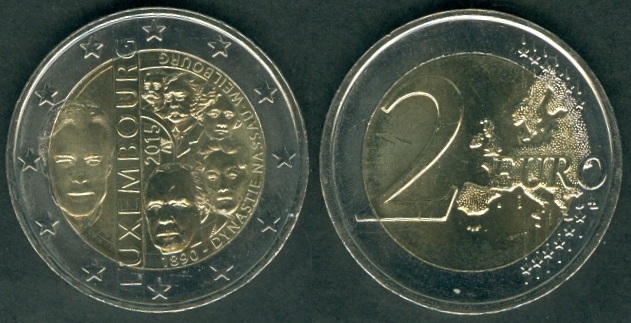 |
Schön#128 2 Euros.
Year: 2015.
Weight: 8.46g.
Metal:
Bi-Metallic; Brass center in
Copper-nickel ring. Diameter:
25.75 mm.
Thickness:
2.20 mm.
Edge:
Reeded and lettering;
The sequence "2 * *" repeated six times
alternately upright and inverted..
Alignment: Medal.
Mint: Utrecht. |
|
Obverse:
On the left of the coin is the effigy of His Royal Highness Grand
Duke Henri, and on the right, in a circular arrangement, and in
chronological order of their accession to the throne, the portraits
of their Royal Highnesses Grand Dukes Adolphe and Guillaume IV,
Grand Duchesses Marie-Adélaïde and Charlotte, and Grand Duke Jean.
To the right, also in circular format, is the inscription ‘1890 -
DYNASTIE NASSAU-WEILBOURG". The name of the issuing country,
"LUXEMBOURG", and the year, ‘2015’, run vertically in the centre of
the design. The coin's outer ring depicts the 12 stars
of the European flag.
Reverse:
Map of Europe with the denomination
shown in Latin characters.
Mintage:
500,000 +
10,000 in coin cards + 1,500 in Proofs.
Minted Years: One
year type. Issue Date:
15 Oct 2015. Subject:
125th Anniversary of the House of Nassau-Weilburg
(1890-2015). |
|
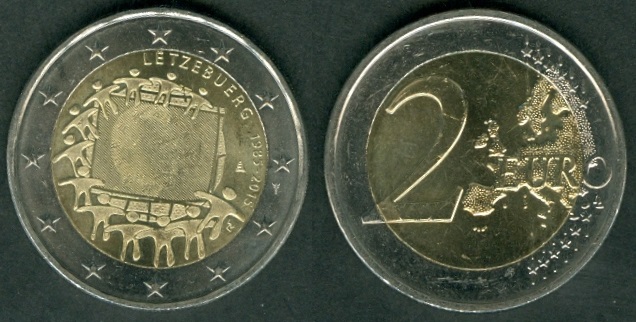 |
Schön#129 2 Euros.
Year: 2015.
Weight: 8.50g.
Metal:
Bi-Metallic; Brass center in
Copper-nickel ring. Diameter:
25.75 mm.
Thickness:
2.20 mm.
Edge:
Reeded and lettering;
The sequence "2 * *" repeated six times
alternately upright and inverted..
Alignment: Medal.
Mint: Utrecht. |
|
Obverse:
The design shows the 30 years of EU flag as a symbol that unites
people and cultures with shared visions and ideals for a better common
future. Twelve stars that morph into human
figures are embracing the birth of a new Europe. At the top right, in
semi-circle, are the issuing country ‘LËTZEBUERG’ and the years ‘1985-2015’.
At the bottom right are the initials of the artist (Georgios
Stamatopoulos).
The twelve stars of the European Union surround the design
on the outer ring of the coin. Hologram of Grand Duke Henri in the
center.
Reverse:
Map of Europe with the denomination
shown in Latin characters.
Mintage:
500,000 +
7,000 in coin cards + 500 in Proofs.
Minted Years: One
year type. Issue Date:
03 Dec 2015. Subject:
30 years of EU flag
(1985-2015). |
|
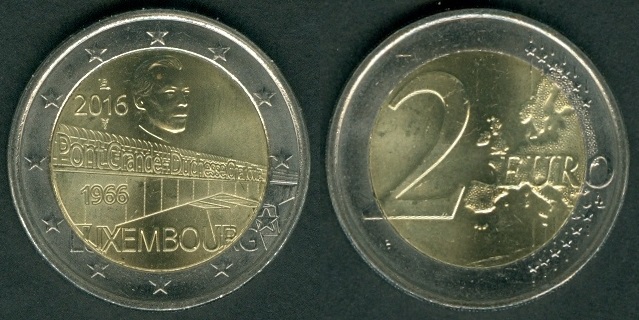 |
Schön#133 2 Euros.
Year: 2016.
Weight: 8.48g.
Metal:
Bi-Metallic; Brass center in
Copper-nickel ring. Diameter:
25.75 mm.
Thickness:
2.20 mm.
Edge:
Reeded and lettering;
The sequence "2 * *" repeated six times
alternately upright and inverted..
Alignment: Medal.
Mint: Utrecht. |
|
Obverse:
Portrait of Grand Duke Henri in the
top within the center circle. Grand Duchess Charlotte Bridge in the center with
Year "2016" at the top left side and "1966" within the Bridge below
the it. "Pont Grande-Duchesse Charlotte" (Grand Duchess Charlotte
Bridge) written in French on the Bridge. "LUXEMBOURG" written below the Bridge. The twelve stars of
the European Union surround the design on the outer ring of the
coin.
Reverse:
Map of Europe with the denomination
shown in Latin characters.
Mintage:
500,000 +
6,000 in coin cards + 1,500 in Proofs.
Minted Years: One
year type. Issue Date:
06 May 2016. Subject:
50 years of
Grand Duchess Charlotte Bridge
(1966-2016). |
|
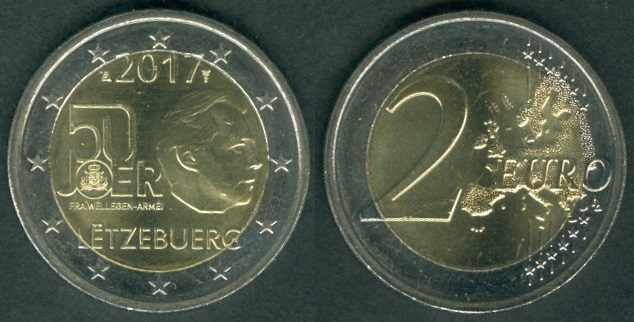 |
2 Euros.
Year: 2017.
Weight: 8.50g.
Metal:
Bi-Metallic; Brass center in
Copper-nickel ring. Diameter:
25.75 mm.
Thickness:
2.20 mm.
Edge:
Reeded and lettering;
The sequence "2 * *" repeated six times
alternately upright and inverted..
Alignment: Medal.
Mint: Utrecht.
Mintmark:
Flag with star (Dutch mint). |
|
Obverse:
Year "2017" at the top
within inner circle. 50 years logo of Volunteer Army at the center
left side with legend "50 JOER FRAÏWËLLEGEN-ARMÉI" (50 years of
Structured Army). Portrait of Grand Duke Henri facing right at the center
right side. "LËTZEBUERG" (Luxembourg) written at the bottom of inner
circle. The twelve stars of
the European Union surround the design on the outer ring of the
coin.
Reverse:
Map of Europe with the denomination
shown in Latin characters.
Mintage:
300,000 +
12,500 in coin cards + 1,000 in Proofs.
Minted Years: One
year type. Issue Date:
02 January 2017. Subject:
50 years of
Luxembourg Volunteer Army
(1967-2017). The Luxembourg
Army is the national military founded on 16 February 1881. The army
has been an all-volunteer force since 29 June 1967. It has a current
strength of approximately 450 professional soldiers (340 enlisted
recruits and 100 civilians). |
|
 |
2 Euros.
Year: 2018.
Weight: 8.53g.
Metal:
Bi-Metallic; Brass center in
Copper-nickel ring. Diameter:
25.75 mm.
Thickness:
2.20 mm.
Edge:
Reeded and lettering;
The sequence "2 * *" repeated six times
alternately upright and inverted..
Alignment: Medal.
Mint: Sint
Servaasbrug.
Mintmark:
Pesac (Dutch mint). |
|
Obverse:
Portrait of Grand Duke
Henri facing right in the top left side within the center circle. Years "1868-2018"
and "150 ANS" (150 Years) written at the top
right side in three lines within inner circle. "CONSTITUTION DU
GRAND_DUCHE DE LUXEMBOURG" written in three lines below Henri's
portrait at the bottom within inner
circle. The twelve stars of
the European Union surround the design on the outer ring of the
coin.
Reverse:
Map of Europe with the denomination
shown in Latin characters.
Mintage:
300,000 +
15,000 in coin cards + 1,000 in Proofs.
Minted Years: One
year type. Issue Date:
27 December
2017.
Subject:
150 years since
the Constitution of Luxembourg
(1868-2018). |
|
| |
| |
|
|
|
|
|
|
Countries
/ Territories |
| |
|
Chiefa Coins |
|
|


















































































































